#Satoshi Kanada
Explore tagged Tumblr posts
Text
HELL DOGS (2022) ★★★★☆
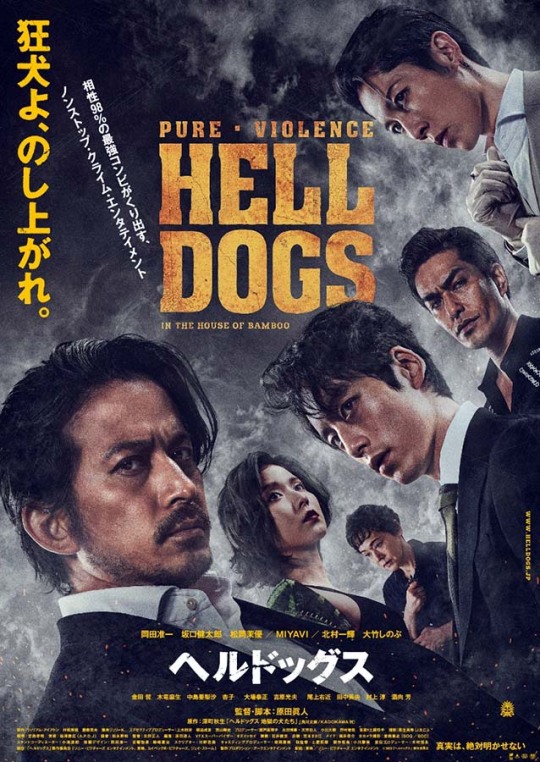
View On WordPress
#Arisa Nakajima#Jun Murakami#Junichi Okada#Kazuki Kitamura#Kentarô Sakaguchi#Mai Kiryû#Masato Harada#Mayu Matsuoka#Mitsuo Yoshihara#Miyavi#Satoshi Kanada#Shinobu Ôtake#Ukon Onoe#Yasumasa Ôba#Yoshi Sakô
5 notes
·
View notes
Text
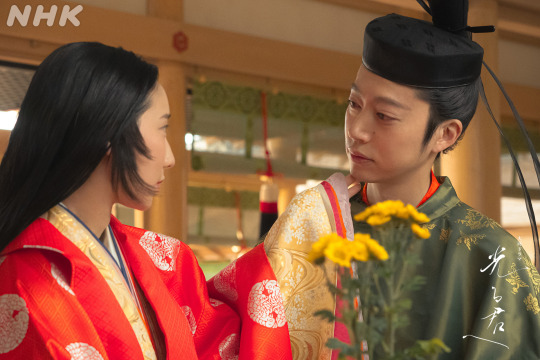
when i said i giggled and kicked my feet in the air after seeing this image – y'all! i love the both of them so much! sei shōnagon's relationship with tadanobu is one of my favourite parts of the pillow book; they have such fantastic banter and chemistry with one another, and i'm so glad to see first summer uika and kanada satoshi translate that into the drama series.
this part of the book where shōnagon talks about how beautiful tadanobu makes me swoon every time:
“he looked magnificent as he came towards me. his resplendent, cherry-coloured court cloak was lined with material of the most delightful hue and lustre; he wore dark, grape-coloured trousers, boldly splashed with designs of wisteria branches; his crimson under-robe was so glossy that it seemed to sparkle, while underneath one could make out layer upon layer of white and light violet robes. as the veranda on which he sat was very narrow, he leaned forward so that the top part of his body came almost up to the blind and i could see him clearly. he looked like one of the gentlemen who are depicted by painters or celebrated by the writers of romances.”
#hikaru kimi e#taiga drama#jdrama#historical drama#sei shonagon#fujiwara no tadanobu#the pillow book
13 notes
·
View notes
Text

Let's conclude our Cutie Honey 50th anniversary trivia with the final episode: “A Poison Flower Falls to Hell.”
Screenwriter: Masaki Tsuji
Art Director: Urata Mataharu
Animation Director: Satoshi Jingu
Director: Osamu Kasai
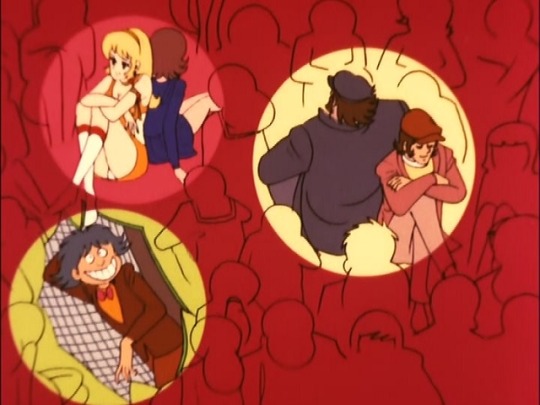
With the exception of Junpei’s girlfriend Mami and the nameless Panther Claw subordinates, all of the (living) characters in the series appear for the final episode.

The suspenseful drumming that plays before Eagle Panther attacks the truck was lifted from Go Misawa’s soundtrack for Devilman.

Honey's final "Honey Flash" animation was recycled from episode 22. Only the background was changed.

Honey has always lovingly addressed her father as “papa”, but in this episode she refers to him as the more formal otousama or “father.” This was probably done to demonstrate to the audience how much she has grown from her battle with Panther Claw.
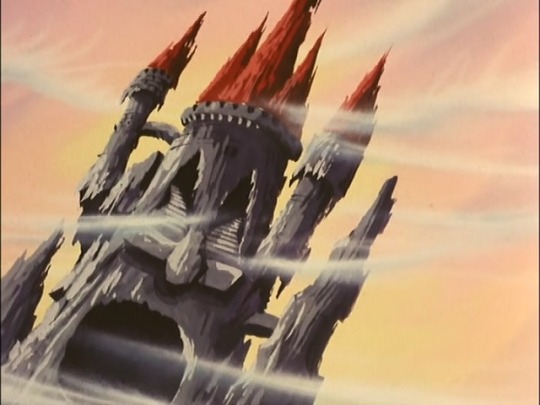
In the original manga, Sister Jill’s headquarters was called maboroshi jyou or “Castle of Illusion.” The name was probably changed to avoid confusion with Cutter Claw’s “Castle of Illusion” from episode 10.
Jill’s headquarters in the manga looks like a traditional European style castle, while the anime version evokes more of a haunted house.
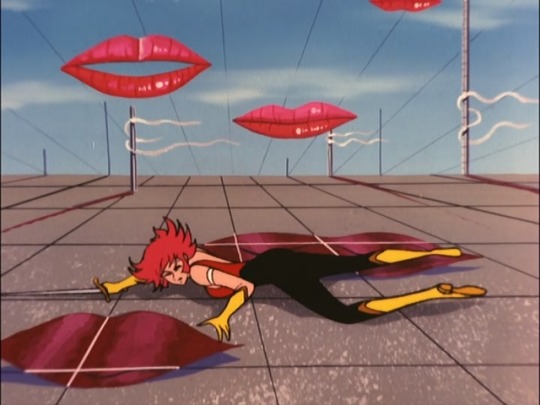
The dreamlike landscape Honey falls into is modeled after the surrealist works of Salvador Dali, specifically one of his most famous works, The Persistence of Memory, which depicts melting pocket watches. The floating lips could possibly be based on Man Ray’s Observatory Time: The Lovers, a painting featuring a giant pair of lush red lips in the sky.
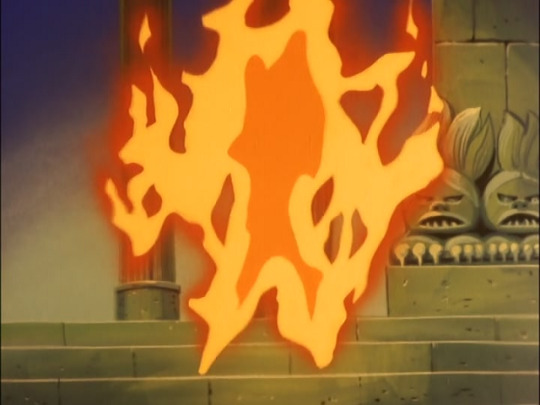
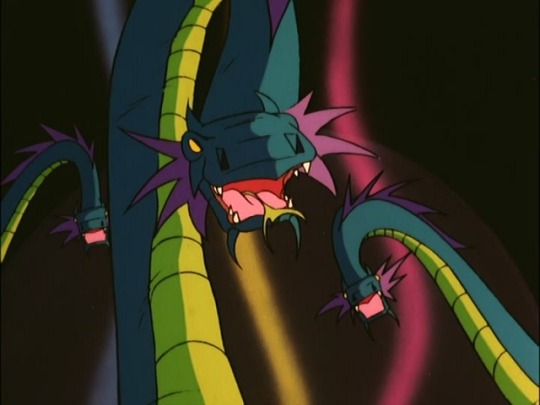
The second half of the episode features a few references to one of Toei Animation’s earlier films, The Little Prince and the Eight-Headed Dragon.
Released in 1963, the film tells the story of Susanoo, the youngest son of the gods who created the Earth, and his journey in finding his mother. The stylized film featured the talents of animation veterans such as Yasuo Otsuka, Yoichi Kotabe, Isao Takahata, and Kimio Yabuki.
References to The Little Prince and the Eight-Headed Dragon:
The human shaped fire that attacks Honey is animated almost exactly like the Fire God that Susanoo faces.
The phantom serpents are a dead-ringer for the eight-headed dragon. The only difference is the coloring. In the film their colors are similar to Maleficent's dragon form from Walt Disney’s Sleeping Beauty. It’s worth mentioning in the original storyboard the illusions were meant to look like generic snakes.
After the Panther Chateau crumbles, the gloomy skies clear up and Honey finds herself in a flowerbed under a blue sky. This is similar to the end of the film, in which the defeated dragon turns into a field of flowers and the dark skies become bright and sunny.

The serpents with humanoid faces were voiced by Nobuyo Tsuda, the same actress who plays Hystler and Panther Zora.
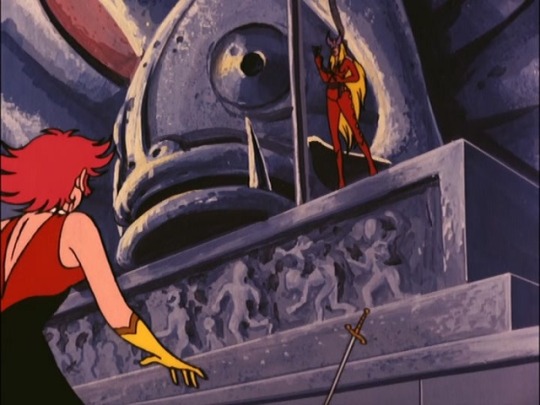
The bone-chilling organ music that plays during Honey and Jill’s confrontation is Fugue in D Major, BWV 580 by Johann Sebastian Bach. The rendition featured in this episode was performed by French organist Marie-Claire Alain.
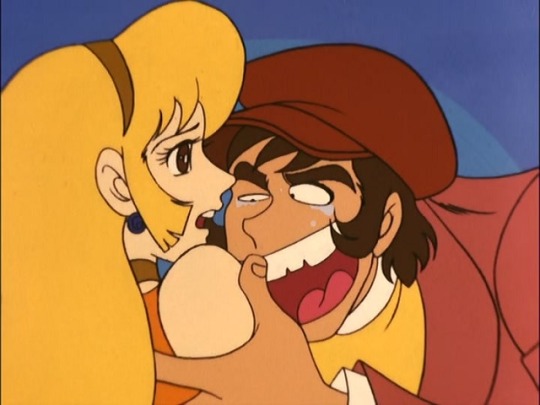
While the animation director for the finale is Satoshi Jingu of Anime Room, the key animation for the second half of the episode was handled primarily by Yoshinori Kanada. While he was relatively unknown at the time, he would go on to be a very influential figure in the animation world, working on titles such as Dino Mech Gaiking, Birth, Princess Mononoke and others. Kanada’s style is particularly noticeable during the “Honey Special” sequence and Honey's reunion with the Hayami family.
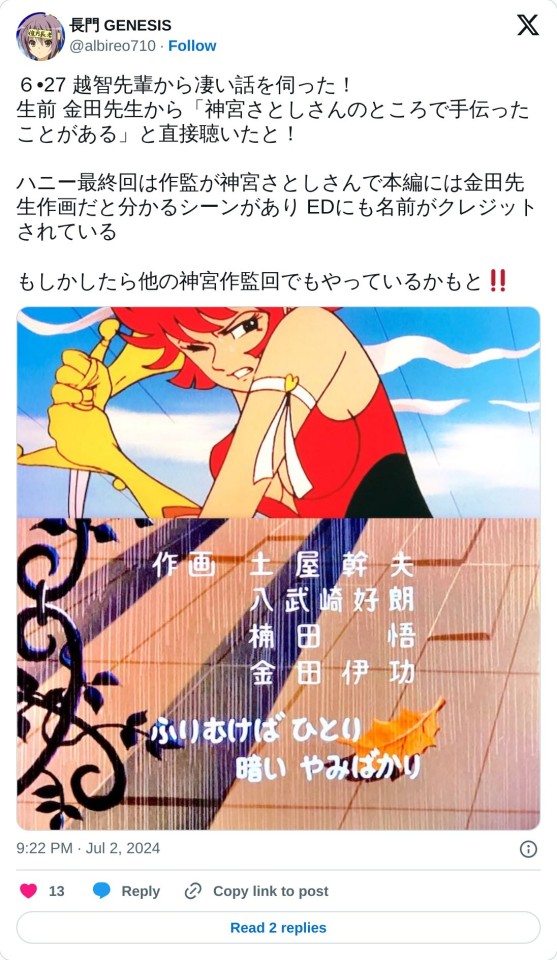
Although this is the only instance where Kanada is listed in the credits, Kazuhiro Ochi has confirmed he did in fact work on the other episodes that were animated by Anime Room (6, 13, 24, and 25).
Supposedly, the final episode was originally going to be handled by Shingo Araki and Hiroshi Shitara, but both men were too busy working on Majokko Megu-chan.

The original storyboard describes clouds around a mountain changing into the form of Panther Zora during the closing scenes. In the finalized episode, Zora simply appears in the sky.

Despite getting pretty good ratings, Cutie Honey was canceled due to concerns over salacious content. According to Go Nagai’s autobiographical manga, Gekiman! Cutie Honey Hen, nearly everyone involved was blindsided by the cancellation. Toshio Katsuta in particular was quite surprised, since Honey made better ratings than its predecessor, Microid S. Katsuta was actually quite confident Honey would last three or four seasons.
Because of the series' abrupt cancellation, Katsuta and Nagai both agreed to have Honey defeat Jill at the end of the series, while leaving Panther Zora’s fate being left to the interpretation of the fans.
In an interview printed in the 1981 Cutey Honey Roman Album, Go Nagai talks a little bit about what Honey and Zora were up to after the finale. He says Zora began harvesting animals from the Amazon and transforming them into androids, probably in preparation for a battle against Honey. He also says Honey is destined to only fight Panther Claw, so she'd probably ignore any unrelated criminal activity. I guess we can assume Honey got a little downtime after her victory against Sister Jill?
And that's all our trivia for Cutie Honey! I hope you enjoyed all the interesting tidbits I've collected over the years. Maybe someday I'll do this for the other series...

Special Thanks:
@brickme
Ayumi Shinozaki
Josh M.
Charlie from Skaro Hunting Society
Phix Cabral
Jonathan Castleman
16 notes
·
View notes
Text
SEGUNDA PARTE
Sigo con la lista de anime también conocida como "dejad que la tita Teknomagic os explique cómo darle en el morro a ese profe vuestro que se burla de los narutos" que empieza en este post:
One Piece: El Barón Omatsuri y la isla secreta (Mamoru Hosoda – 2005, Toei)
con las películas de series ocurre que a veces hay directorazos dando sus primeros pasos con ellas, y aquí pasa justo eso. Es la sexta película de One Piece y con ella se estrenó en largometraje el director de Summer Wars y Belle.
(por cierto: Summer Wars es un peliculote también)
youtube
Space Dandy (varios directores – Bones, 2014)
esta space opera consta de capítulos autoconclusivos, cada uno con un director distinto y mucha libertad creativa.
youtube
Promare (Hiroyuki Imaishi – Trigger, 2019) no me puedo dejar a Imaishi fuera de la lista y Promare es un poco todas sus movidas concentradas en una película.
youtube
Keep Your Hands Off Eizouken! ( Masaaki Yuasa – Science Saru, 2020) vale, esta serie tampoco la he visto pero es un poco especial porque va sobre animación.
youtube
Bonus track: Yoshiyuki Tomino. Yo que sé, escoged un Gundam de los suyos, el que queráis. Ha levantado una de las mayores franquicias de Japón casi él solo, cómo voy a recomendar UNA obra, es un titán del medio.
youtube
O si no cualquier cosa suya, como por ejemplo Overman King Gainer.
Bonus track 2: Satoshi Kon tampoco tiene ni una película ni una serie mala. Personalmente me gustó mucho Paranoia Agent, pero toda su obra vale muchísimo la pena.
youtube
Luego aparte podéis entrar en Sakugabooru y buscáis los tags de Itano circus, Yotapon cubes, Kanada dragon, Wakame shadows e Hisashi punch, por ejemplo (son efectos de animación nombrados en honor al animador que los inventó o popularizó, una gozada, dadle bien fuerte con esto también a los profes odiaanime. Bueno, les podéis dar con la web entera)
23 notes
·
View notes
Text
https://myanimelist.net/anime/15489/Yu%E2%98%86Gi%E2%98%86Oh_Zexal_Second/characters
Let’s do the ZEXAL 2 repeat characters:
**Shouma Yamamato does V, Yamikawa, and Akira
https://myanimelist.net/people/12835/Shouma_Yamamoto
**Sachi Kokuryu does Tron, and Sly (one of Lua’s schoolmates):
https://myanimelist.net/people/5997/Sachi_Kokuryu
**Yuuko Sanpei does both Obomi, and Haruto:
https://myanimelist.net/people/407/Yuuko_Sanpei
**Satoshi Hino does Vector, Mani, and Kagurazaka:
https://myanimelist.net/people/245/Satoshi_Hino
**Ryouko Shiraishi does Haru, and Ponta:
https://myanimelist.net/people/348/Ryouko_Shiraishi
**Tomoaki Maeno does Orbital 7, and Ukyo Kitano (Mr. Kay in dub):
https://myanimelist.net/people/1489/Tomoaki_Maeno
**Aki Kanada does young Ryouga, Tokunosuke, Carly (after Episode 130), and Torunka:
https://myanimelist.net/people/930/Aki_Kanada
**Miyu Irino (Sora from Kingdom Hearts) does Astral, and Number 96:
https://myanimelist.net/people/88/Miyu_Irino
**MAMORU MIYANO does Daisuke, and Abidos:
https://myanimelist.net/people/65/Mamoru_Miyano
**Yoshimasa Hosoya does IV, and Reiji:
https://myanimelist.net/people/5626/Yoshimasa_Hosoya
**Mie Sonazaki does Umimi, and Sora:
https://myanimelist.net/people/602/Mie_Sonozaki
**Daisuke Hirakawa does Charlie, and Durbe:
https://myanimelist.net/people/183/Daisuke_Hirakawa
**Mitsuru Miyamoto does Kouji Satou (Mr. Stein in the dub), and Don Thousand:
https://myanimelist.net/people/1469/Mitsuru_Miyamoto
******
For ZEXAL I:
https://myanimelist.net/anime/10015/Yu%E2%98%86Gi%E2%98%86Oh_Zexal/characters
**Yasuaki Takumi does both Michio, and Coyote:
https://myanimelist.net/people/11510/Yasuaki_Takumi
**Takuya Eguchi does Shuuta, Yuuro, and Zuwijo:
https://myanimelist.net/people/7695/Takuya_Eguchi
**Ken Narita does Giese Hunter, and Jin:
https://myanimelist.net/people/109/Ken_Narita
**Anri Katsu does Mitsuo, and Wolf:
https://myanimelist.net/people/756/Anri_Katsu
**Kenji Nomura does Demack, and Housaku (the Tomato guy):
https://myanimelist.net/people/299/Kenji_Nomura
As a general rule, a lot of characters who had bit roles in the past got more bit roles due to episodic nature of the show. Because ZEXAL had a huge budget, a lot of high profile actors are here for bit roles as glorified cameos.
1 note
·
View note
Photo

Bitcoin Mucidi Satoshi'nin Kimliği Üzerine Yeni İddia! Bitcoin’in yaratıcısı Satoshi Nakamoto’nun kimliğine dair yeni bir iddia gündeme getirildi. HBO’nun yayınladığı bir belgeselde, Kanada kökenli Bitcoin geliştiricisi Peter Todd’un Sa https://bursahabermedya.com/bitcoin-mucidi-satoshinin-kimligi-uzerine-yeni-iddia/ #Dünya #bursahaber #bursasondakika #bursahaberleri #haberler #bursa
0 notes
Text
Andreas Antonopoulos, çok satan bir muharrir, konuşmacı, eğitimci ve Bitcoin ve açık blok zinciri teknolojilerinde çok aranan bir uzmandır. Karmaşık bahisleri anlaşılmasını kolaylaştırması ve bu teknolojilerin global toplumlarımız üzerindeki hem olumlu hem de olumsuz tesirlerini vurgulaması ile tanınır.Andreas Antonopoulos HayatıAndreas M. Antonopoulos İngiliz-Yunan asıllı Bitcoin savunucusu, teknoloji teşebbüsçüsü ve müelliftir. 1972’de Londra’da dünyaya gelmiştir.Antonopoulos 1972’de Londra, Birleşik Krallık’ta doğdu ve Yunan Cuntası sırasında Yunanistan’ın Atina kentine taşındı. Çocukluğunu orada geçirdi ve 17 yaşında İngiltere’ye döndü. Andreas Antonopoulos, University College London’dan Bilgisayar bilimi ve Bilgi İrtibatı, Ağlar ve Dağıtılmış Sistemler alanlarında derece aldı.2003’ten 2011’e kadar Nemertes Research’te Kıdemli Lider Yardımcısı ve Kurucu Ortak olarak misyon yaptı. Oradayken, Antonopoulos bilgisayar güvenliğini araştırdı ve bilgisayar güvenliğine yönelik en büyük tehdidin tecrübeli bilgisayar korsanları değil, çok karmaşık sistemler olduğunu belirtti.2012’de Andreas Antonopoulos, Bitcoin’e aşık oldu. Sonunda özgür danışman olarak işini bıraktı ve konferanslarda bitcoin hakkında konuşmaya, yeni başlayanlar için danışmanlık yapmaya ve fiyatsız makaleler yazmaya başladı.Ocak 2014’te Antonopoulos, baş güvenlik vazifelisi olarak Blockchain.info’ya katıldı. Eylül 2014’te STK rolünden ayrıldı.Nisan 2014’te Andreas Antonopoulos, bir Newsweek makalesinde Bitcoin’in yaratıcısı Satoshi Nakamoto olarak tanımlanan Dorian Nakamoto için bir bağış toplama kampanyası düzenledi. Makalede kullanılan raporlama teknikleri, gazeteciler ve Bitcoin topluluğu üyeleri ortasında tartışmalıydı. Makale sonucunda gördüğü ilgiden sonra Nakamoto’ya yardımcı olmayı amaçlayan bağış toplama aktifliği, o sırada 23.000 ABD Doları pahasında 50 Bitcoin topladı.8 Ekim 2014’te Antonopoulos, Kanada Senatosu’nun Bankacılık, Ticaret ve Ticaret komitesi önünde senatörlerin Kanada’da Bitcoin’in nasıl düzenleneceğine ait sorularını ele almak için konuştu.Mart 2016’da, Mastering Bitcoin’in birinci baskısı Antonopoulos tarafından basılı ve çevrimiçi olarak, akabinde Haziran 2017’de ikinci baskısı yayınlandı.Aralık 2017’de, Roger Ver’in 5 Aralık’ta Twitter’da Andreas Antonopoulos’un 2012’den beri Bitcoin hakkında “belirgin” kamuya açık konuşması göz önüne alındığında yatırım seçimlerini sorgulayan bir kamuya açık gönderi yapmasının akabinde, Antonopoulos’a çalışmalarının binden fazla takipçisi tarafından 100’den fazla Bitcoin’in istenmeyen bağışları gönderildi.
0 notes
Text
Animation Night 118: return of the 90s realists!
Heyo friends!
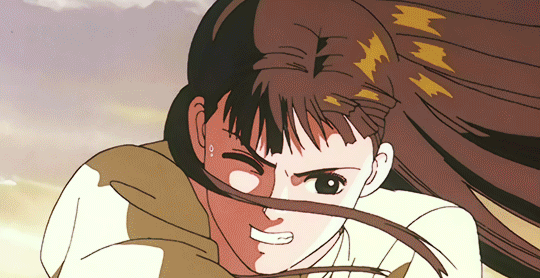
So! Katsuhiro Otomo and friends~ You know all about that guy no doubt. After all, he directed Akira! (I wrote about the original context of Akira on Animation Night 34.) And he was heavily involved in the short film compilations like Robot Carnival and Memories of the 80s and 90s which got this whole film night going~
The group of animators who worked on these films have come to be known as the ‘realist school’, although in truth there are several schools that could be described as such. (When asked by a fan what he thought of Royal Space Force: The Wings of Honneamise, certainly a milestone for ‘realism’ with Anno’s incredible animation of a rocket taking off, Isao Takahata was not a fan.) The realists include directors like Satoshi Kon, and animators like Mitsuo Iso, and Robot Carnival also marked the starting point for figures like Koji Morimoto of 4C.
As ever, I’m immensely grateful to Matteo Watzky for helping me understand their lineage! And while we’ve watched most of the films associated with this loose gaggle of animators on Animation Night, there are a couple of major gaps...

So! Roujin Z (1991), a movie that’s just a couple of months older than me, adapts an Otomo story about a robotic hospital bed, and shares many of the same staff including animation legends like Hiroyuki Okiura (animator of this legendary sequence) and Toshiyuki Inoue.
The director this time was not Otomo himself, but Hiroyuki Kitakubo, who had - before Akira! - debuted on foundational hentai Cream Lemon and adapted a Shirow manga to OVA; he would later direct the delightful Golden Boy (Animation Night 69) and the startlingly stylish Blood the Last Vampire (Animation Night 77).
And if we wander back to Robot Carnival, he directed the very sardonic A Tale of Two Robots: Chapter Meiji, in which a kind of steampunk Japanese robot fights a similar American robot to a destructive standstill in a kind of parody of the Meiji restoration. So strong expectations?
So what about the movie? Compared to something like Akira, Roujin Z is much more wrly humorous in tone - very similar in fact to the segment Stink Bomb in Memories, in that it’s a kind of disaster movie with jaw-dropping animation applied to a premise that plays with Otomo’s own reputation for dark spectacular disaster, playing with the idea of an aging population increasingly reliant on tech.
Basically? It’s been a movie I’ve wanted to watch for a good while, and now we can finally run it!

Now Junkers Come Here came just a few years later, in 1995, but of course the landscape had been drastically transformed by Eva and the realist movement had more time to come into their own, with the rise of Mamoru Oshii’s movies like Ghost in the Shell (Animation Night 39).
Junkers is something different than all this extravagant sci-fi. Adapting a novel series, it portrays the story of Hiromi Nozawa, a young girl going through a personal crisis with family and school who finds unexpected comfort in the form of a talking, wish-granting dog called Junkers.
The first version of Junkers was given to the true legend Shinya Ohira, but his pilot proved both too expensive and too experimental (looking at the standard of animation involved, perhaps we can see why!), so the powers that be gave it instead to Jun’ichi Satō of Sailor Moon, and added animation director Kazuo Komatsubara, an established Kanada School animator.
Here’s an excerpt from Watzky’s article...
Although Komatsubara was by all means a living legend, bringing him on the movie can only be read as a conservative move: putting an established and experienced figure on the movie would have been a guarantee that it would not try to be as challenging as Ohira’s pilot had been.
The movie did, however, feature excellent animation work—Tanabe and Iso, especially, were the stars of the show, while Ohira had more or less left the project. It must also be noted how much Satô’s direction was instrumental in highlighting the animation. The simple storyboards were always made in such a way to have multiple actions on screen, allowing the different characters to interact in the frame and the animators to give the full measure of their talent.
More than anything, it’s an exploration of subtle character acting - featuring an incrediblely subtle cut of quiet emotional devastation by animation god Mitsuo Iso and really lively, expressive animation of eating by Osamu Tanabe.

So in short: expect both of these movies to be absolute animation powerhouses, in different ways. Oddly, while Roujin Z tends to be at least noted as a footnote when talking about Otomo, Junkers Come Here seems to have largely been forgotten - if it wasn’t for Watzky I would never have heard of it. A big shame because it seems like a fantastic expression of one of the most challenging styles of animation - and one I feel I personally really need to cultivate lol...
Right so! With the time being as late as it is, that’s about all I can write for now. So, Animation Night 118 will go live now at picarto.tv/canmom, and we should start showing films in about 20-30 minutes! Hope to see you there!!
27 notes
·
View notes
Text

Yu Yu Hakusho: Poltergeist Report released on April 9, 1994.
Studio(s): Studio Pierrot and Movic
Director: Masakatsu Iijima
Producers: Haruo Sai, Ken Hagino, and Naoji Hōnokidani
Score: Yusuke Honma
I'll also list all of the artists involved in making the background art and the key animators! This movie looks incredible and directors tend to get a much bigger cut of the credit than they deserve.
Background Art: Emi Kitahara, Emiko Koizumi, Hideaki Kudo, Hirofumi Shiraishi, Hisae Saito, Hitoshi Nagasaki, Ikuko Ōoka, Kaoru Inoda, Kazuo Ebisawa, Kumiko Nagashima, Masumi Nishikawa, Mio Isshiki, Ryō Kōno, Sadayuki Arai, Sawako Takagi, Shigenori Takada, Shinichi Uehara, Shinobu Takahashi, Shuichi Hirose, Toshiharu Mizutani, Toshiyuki Yoshimura, Yasunari Usuda, Youngil Park, Yuka Kawashima, Yuka Okamoto, Yūko Kobayashi
Key Animation: Akihide Saitō, Chihiro Hayashi, Fuminori Kizaki, Hajime Kamegaki, Hideyuki Motohashi, Hikaru Takanashi, Hiroharu Nishida, Hiromi Niioka, Hirotaka Kinoshita, Hiroyuki Kanbe, Hiroyuki Okuno, Hisahito Natsume, Isao Sugimoto, Junichi Kigawa, Junko Abe, Kari Higuchi , Katsuichi Nakayama, Kazumi Minahiro, Kazuya Kuroda, Kazuyuki Ikai, Kazuyuki Kobayashi, Keiko Shimizu, Kenji Yamazaki, Kunihiko Ito, Mamoru Hosoda, Mamoru Kurosawa, Masahito Yamashita, Masaki Hosoyama, Masayuki Fujita, Mayumi Hirota, Munenori Nawa, Naoyuki Owada, Osamu Nabeshima, Satoru Iriyoshi, Satoshi Fukushima, Shinji Seya, Shinsaku Kōzuma, Shuji Kawakami, Shunji Suzuki, Susumu Yamaguchi, Tadakatsu Yoshida, Tadashi Abiru, Takashi Yamazaki, Takayuki Gorai, Takenori Mihara, Takuya Satō, Toyoaki Shiomi, Yasunari Nitta, Yoshiaki Tsubata, Yoshinori Kanada, Yoshiyuki Kishi, Yuichi Endo, Yuko Kusumoto
54 notes
·
View notes
Text
FEATURE: How I Got Into Sakuga

Kaiba, Directed by Masaaki Yuasa
If you’re an anime fan, you’re likely an animation fan in general. But how do you know when an animation is “good”? How do you learn to identify an animator by only what you see, or tell when their drawings are better than usual?
English-speaking anime fans have adopted sakuga as a general catch-all term for exceptional animation. While the word sakuga itself means “animation,” in this context, sakuga has come to mean something very specific: Not just animation that looks cool, but the deliberate handiwork of specific animators with specific artistic aspirations. For example, a single-animator project might have a lot of “sakuga shots” because it has a personal, highly-refined style. Meanwhile, a television series might have an entire team of varying specialists for a larger narrative. Some of this might be attributed to specific key animators, while some might be credited to an entire studio — transformation sequences, explosive missiles, robots — that’s all fair game to be called sakuga. But how do you really know if what you’re looking at really is this so-called “sakuga?”
Like most art, it’s almost entirely subjective. Here’s my story.
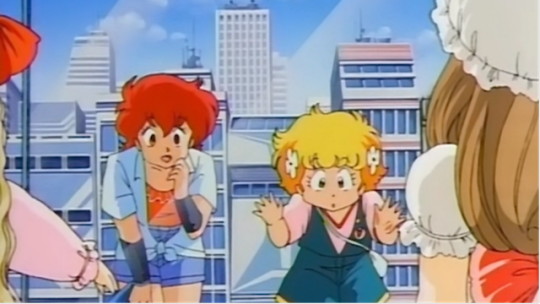
Project A-ko, a high-energy 1986 OVA series best remembered for its exceptional animation staff
(Image via Retrocrush)
All’s Fair in Love and War Games
When I was a kid, I got my hands on the English-dubbed Digimon: The Movie on VHS. This notorious release was a three-part recut of Mamoru Hosoda’s Digimon OVAs released from 1999 to 2000, heavily featuring his second film Digimon Adventure: Our War Game. Of course, I didn’t experience this package as a “Hosoda anime” at the time. Besides the inspired inclusion of Barenaked Ladies’ "One Week" to the soundtrack, I strongly associate these films with Hosoda’s signature interpretation of Katsuyoshi Nakatsuru’s original Digimon Adventure character designs. Compared to the Toei-produced television series, these renditions of the Digi-Destined are charmingly off-model and move with awkward intention, like actual kids up against terrifying monsters.
In a sense, that’s what most people mean by sakuga — animation that makes us lean in and notice traits about the world and characters that can’t be communicated otherwise. Sakuga, in particular, places special emphasis on an individual animator’s keyframes, or the drawings used as a basis for in-between frames during movement. That’s what I mean by the phrase “Hosoda anime.” If you watch Summer Wars or The Girl Who Leapt Through Time enough times, anyone will notice a stylistic palette of idiosyncrasies.
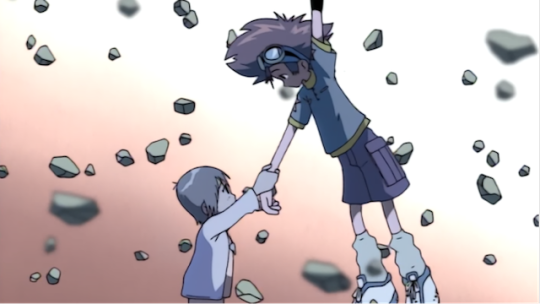
Digimon Adventure “Home Away From Home” directed by Mamoru Hosoda
(Image via Hulu)
An Emerging Style
When I got older and realized there was more anime than what was on cable, I kept returning to “flat” style animation with films like Tatsuo Satō’s 2001 Cat Soup and Shōji Kawamori’s 1996 Spring and Chaos. Around this time, contemporary artist Takashi Murakami also began developing his own “superflat” style (coined in his 2000 book Superflat and later in Little Boy: The Arts of Japan's Exploding Subculture) we’ll return to. Once I got a taste for the experimental, I never turned back.
But back to Hosoda. Less focused on the details of models and more fixated on a “flat” or fluid style of movement, the key animation in Hosoda’s films makes body language a priority. This is perhaps the best thing about good sakuga — its potential to express deep emotion even under production constraints. My favorite example comes from the first Digimon short film Hosoda directed, the simply titled Digimon Adventure from 1999.
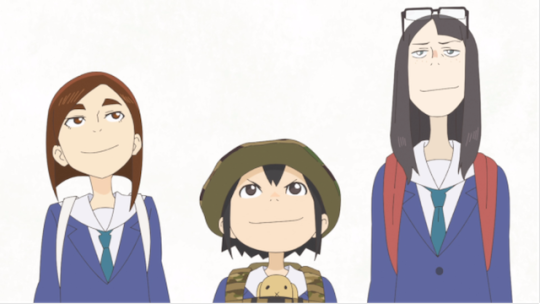
Keep Your Hands Off Eizouken!, Directed by Masaaki Yuasa
Originally conceived as a standalone for Bandai’s then-new Digital Monsters virtual pet toys, this version of Digimon is less loud, more atmospheric — and sincerely preoccupied with the question: “How would little kids actually handle a giant monster of their own?” The result is an unforgettable shot of Kairi, Tai’s little sister desperately blowing her whistle, stopping to catch her breath, then spitting and coughing in an attempt to calm down their newly evolved kaiju Greymon friend.
For the television series, Hosoda directed the episode “Home Away From,” depicting the two siblings clinging to each other as the other slowly drifts back to the Digital World. In both scenes, characters don’t constantly move, but only act when necessary via careful manipulation of the frames. This technique not only makes everything seem more “realistic,” but also acts as a visual cue for the anxiety Tai and Kairi feel. In other words, painstakingly controlled animation serves both form and function, especially when you’re selling an emotional climax of another kid-meets-monster plot.
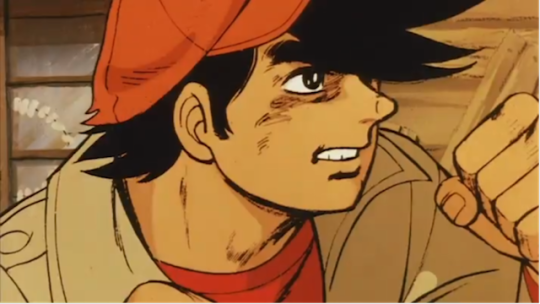
Tomorrow’s Joe, 1980 film adaptation of the 1970 TV anime series directed by Osamu Dezaki
(Image via Retrocrush)
A Little History Lesson
After Digimon, Hosoda and Nakatsuru collaborated on films like Summer Wars and the Takashi Murakami-inspired pop art short Superflat Monogram. Hosoda is no doubt inescapable to sakuga fans today thanks to the ubiquity of his feature films. Still, Hosoda obviously wasn’t the first sakuga animator. Animators like Yasuo Ōtsuka, known for his cinematic work in a pre-Ghibli era of anime film with Toei, documented the growth ‘60s and ‘70s of Japan’s animation industry in his 2013 book Sakuga Asemamire. When the demand for films lowered in favor of anime television during that era, animators took risks. Classics of the era like Tiger Mask and Tomorrow's Joe literally held no punches, and Osamu Tezuka’s own Mushi Productions dove headfirst into experimental adult films. Animators, and especially keyframe animators, had creative control. In this perfect storm, the advent of sakuga was inevitable.
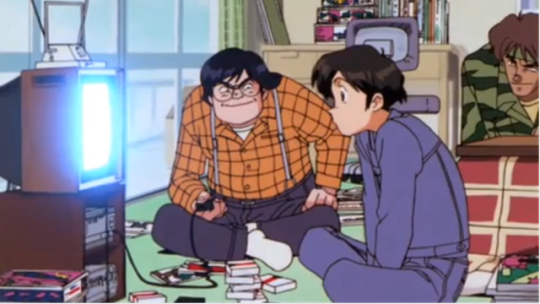
Everyman Ken Kubo is taught the ways of eighties anime in Otaku no Video
(Image via Retrocrush)
Why Bother With Sakuga?
In 2013, animation aficionado Sean Bires and company hosted an informational panel titled “Sakuga: The Animation of Anime” at Anime Central Chicago. Uploaded to YouTube that same year, this panel informed my younger self’s understanding of not just the “how” of sakuga, but the “why” it even needed to exist in anyone’s vocabulary. Accessible, meticulously researched, and full of visual references, Sean’s two-hour panel-lecture does the heavy lifting of contextualizing anime not just through a historical lens, but within the broader project of expanding cinematic techniques. This primer might sound heady, but considering the popularity of Masaaki Yuasa’s series like Keep Your Hands Off Eizouken!, and references to animator Ichirō Itano’s “Itano circus” missiles in American cartoons like DuckTales, it’s hard to say sakuga isn't relevant. Nowadays, it's practically a trope to parody one of Dezaki's most iconic shots. Supplemented by a rich community of blogs and forums, it couldn’t be easier to learn about animators like Yasuo Ōtsuka or the early days of Toei if you want a bigger picture. Blogs like Ben Ettinger’s Anipages and the aptly named Sakuga Blog are a good place to start, not to mention dozens of dedicated galleries of anime production and art books published by studios themselves. Now couldn’t be a better time to vicariously live your art school dreams through anime masterworks.
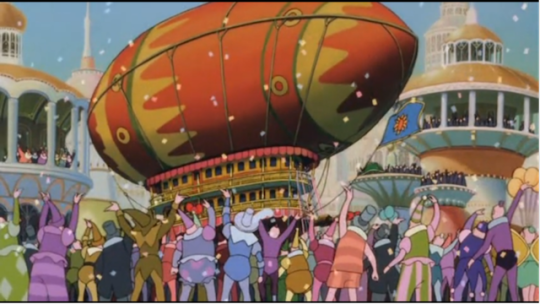
Little Nemo: Adventures in Slumberland, a 1989 film featuring animation by Yasuo Ōtsuka best known for his work on the Lupin III franchise
Sakuga Is For Everyone
Fans have always been obsessed with the technicalities of animation, even if they weren't artists. As early as 2007, uncut dubbed collector box sets for Naruto came with annotated booklets of episode storyboards. More recently, critically-acclaimed series like Shirobako further explicated this love for animation as a team effort — people love attaching other people to art. In contrast, psychological horror series like Satoshi Kon’s Paranoia Agent features an episode about an anime studio’s production going terribly wrong. Not to mention the endlessly self-referential Otaku no Video Gainax OVA and its depiction of zealous sakuga otaku. Anime fans adore watching anime be born over and over. It’s that simple.

Digimon Adventure “Home Away From Home” directed by Mamoru Hosoda
(Image via Hulu)
Today, I’d comfortably call some shots from Hosoda Digimon films great sakuga. But Koromon is still weird. Sorry. The love for sakuga isn’t a contest to one-up fans on production trivia or terminology. It’s about taking the time to appreciate the fact that anime is ultimately a collaborative artistic endeavor. From tracing back the lineage of animators like Yoshinori Kanada to Kill la Kill, to appreciating the visual sugar rush of Project A-Ko alongside slow-paced Ghibli films, “getting into sakuga” isn't a passive effort, nor a waste of time. Besides, wouldn't it be fun understanding how your favorite animator achieved your favorite scene? The phrase "labor of love" is cliché, but maybe that’s a good synonym for what role sakuga inevitably plays for artists and fans alike — work that brings you joy, no matter how you cut it. Who is your favorite animator? When did you get into sakuga? Let us know in the comments below!

Blake P. is a weekly columnist for Crunchyroll Features. His twitter is @_dispossessed. His bylines include Fanbyte, VRV, Unwinnable, and more. He actually doesn't hate Koromon.
Do you love writing? Do you love anime? If you have an idea for a features story, pitch it to Crunchyroll Features!
By: Blake Planty
10 notes
·
View notes
Text

According to the Majokko Daizenshuu or “Magical Girl Companion” the last episode of Cutie Honey was originally going to be handled by Shingo Araki and Hiroshi Shidara. However, when the storyboard process was about to begin, both men were too busy working on Majokko Megu-chan. Ultimately Satoshi Jingu and Osamu Kasai were appointed to work on the final episode.
Araki and Shidara previously worked together on episode 12 of Honey, which would later be shown as part of the spring Toei Manga Matsuri in 1974. It’s definitely a fan-favorite. You can’t talk about the ‘73 series without someone mentioning “that sad mermaid episode.”
While they both worked on the opening and ending credits for Megu-chan, the first episode they collaborated on was episode 27, “The Curse of Scorpio.” This episode opens with Megu watching Misty Honey sing on TV.
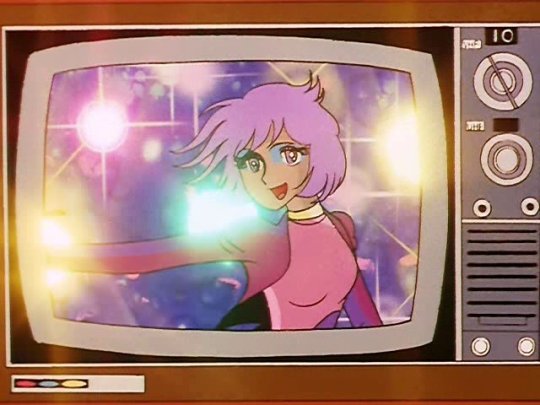
While I’m a bit disappointed Shingo Araki didn’t work on the final episode, I’m glad Hiroshi Shidara didn’t work on it either. I always thought his directing style was a bit lackluster and always preferred Osamu Kasai. It also felt fitting for Kasai to handle Honey’s finale since he did storyboard the iconic opening and ending credits.
Although, I’m not really sure why Jingu was selected as the animation director for the last two episodes. I have no idea how the system worked with Toei back then, maybe there was some sort of rotation with the animators (and the studios)? Cutie Honey was also his first animation director job. Previously he had done in-between and key animation. I recently found out he came from Studio Z, where Shingo Araki had also gotten his start. Maybe Jingu was recommended by Araki?
I also want to mention the second half of the finale was predominately handled by famed animator, Yoshinori Kanada. His style really shines through during the “Honey Special” sequence, as well as Honey’s reunion with the Hayami family.
I think this might’ve been his first major job as a key animator? Apparently he went on to say he barely remembers working on Cutie Honey, lol.


Anyways, hope you enjoyed that interesting bit of Honey trivia!
24 notes
·
View notes
Text
On Animation
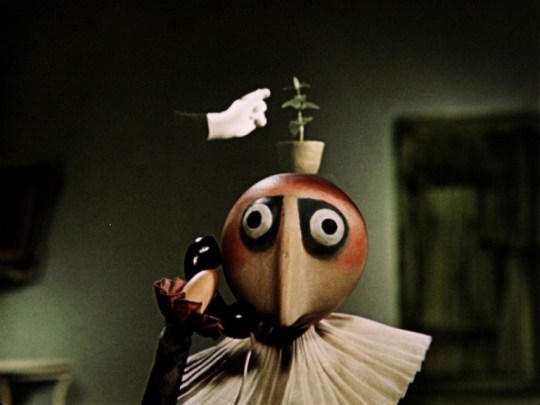
These are mostly some personal views and experiences, you are welcome to read but don’t hold high expectations. In the last 2 years or so I didn’t watch as much anime as I used to, probably because I don’t find anime as entertaining as before. My interest in sakuga and Japanese animators was the first time I found value in animation itself, regardless of other aspects such as the story. The sheer expressive power of Ohira’s drawings, or Kanada’s unique timing, all brought me joy and still do.
Yet even this joy I find in sakuga won’t last forever, and I can say that rarely does any scene amaze me like my first contact with works from not only legendary animators such as Ohira and Kanada, but even Ebata and Tanaka. I didn’t lose my interest in commercial sakuga that’s for sure, most what I watched lately were obscure shows I wanted to see what X animator or X director did in them. It’s just that I’m looking for something new, and I knowingly didn’t experience basically anything the wide medium of animation has to offer.
I think the majority of anime fans, animation fans in general even, just watch animation because it’s “anime” or maybe “Disney”. If an anime with a somewhat good story and almost still good-drawn images was to be produced, I bet it would gain some following and popularity among non-japanese fans at least. I also bet such a thing already happened. This reminds of a funny phrase I heard from a friend: “people think that animation isn’t important in animation”.
But then, everyone is free to prefer whatever they want in my opinion. I just think that people who have this view don’t see the real merit of animation and its real beauty, to a big extent at least. Works with outstanding stories and fascinating themes such as Ghost in the Shell receive praise mostly due to that aspect only, the story and themes, with maybe mentioning “good and smooth” animation as a side point. But such works exhibit what really makes animation what it is and takes of advantage of the capabilities of this medium, just look at the Hollywood adaptation to compare(regardless of the fundamentally different execution).
Maybe the main approach of commercial animation takes most of the blame here. Ask any random person “what is special about animation?”, and probably the answer would be something along the lines of “unlimited imagination” or “fascinating imaginary worlds”, referring to Disney’s princesses or Ghibli's fantasy. Yet live-action movies are capable of creating such worlds thanks to modern and even kinda old technology(if we ignore the ongoing controversy regarding the definition of these works), while other more realistic animation works such as Satoshi Kon’s show animations’ features and perks, the features that are the reason why he famously prefered to use animation in all his movies despite being more of a live-action director in nature. What I’m trying to say is this: animation isn’t just a container with the sole purpose of conveying a story or a message, nor is the importance solely in the content conveyed, but in the way it’s conveyed. That’s why a lot of people who work in animation refuse the idea of mimicking live-action, for example.
After sakuga my interested shifted towards independent and experimental animation especially the japanese ones, like Koji Nanke and Youji Kuri. The story of independent japanese animators is a long one, better covered here. Watching their works made me realize more and more how diverse animation is, and the different exciting ways to transmit an idea through animation. You may say that everything I said till now was just cretesizing commercial animation and praising independent/experimental animation because I love them, yet I didn’t deny that Ghibli and Disney(2D) movies, which are commercial for sure, are some of the best animation works from a technical and artistic standpoint. What I’m criticizing is the narrow outlook on animation, even among the commercial works. Animation isn’t only hand-drawn or 3D, you have collage and stop-motion and puppets and others. It shouldn’t come as a surprise that the former Association of Japanese Animations(AJA) president, the late Kihachiro Kawamoto, never drew anything, he was but an amazing puppet animator. Before Kawamoto was Tezuka, a person who plainly hates commercial mainstream animation and whose experimental works probably outnumber his commercial ones. Kawamoto’s successor, the current president Taku Furukawa, is a renowned independent animator and one of Youji Kuri’s students. Movies such as Isle of Dogs getting a wide positive reception makes me happy.
A famous use of collage was in Madoka Magica’s labyrinths, which Gekidan Inu Curry duo handled. It consists of Shirashi Ayumi(former Gainax) and Anai Yosuke(former defunct studio named Tanto). Their participation in Madoka Magica and many other Shaft shows came probably due to their relation with the director Yukihiro Miyamoto. I went a bit off track, but all this was to say that I enjoy Kihachiro Kawamoto’s collage works especially such as The Trip(1973), although he is better known for his puppet works, that are great nonetheless. This isn’t because I don’t enjoy puppetry, Jiří Trnka amazes me- for example. I bet that his magnum opus, The Hand(1965), would astonish any animation fan not only in its visuals, but in the way it handles and presents its themes as well, which led to banning this movie that obviously opposes the communist occupation of Czech.

from right to lefr: Madoka Magica, The Trip, Kenju Giga.
Now that I mentioned Czech, it’s one of the richest countries when it comes to animation and animation history. Many other east-european countries as well. Trnka is enough on his own, but even with other animation arts it’s a region that has a rich and old history of experimentation and early works. Tezuka’s inspiration for his short Jumping(1984) came from none other than a hungarian short called The Fly(1980). The animator behind Jumping, Junji Kobayashi, reminds me always of a fun fact about Tezuka. Kobayashi himself has a deep passion for insects and wildlife in general. Alongside being a member of multiple insect societies and organisations, including The Japanese Association for Insects, he wrote a book on how to animate animals based on Mushi/Tezuka Pro's principles. But if there's a bigger insects nerd than him, it's Tezuka, who deliberately added the kanji for insect(虫) in his pen name(same reading to his original name). Tezuka also has some books on insects or animals, in a fictional or realistic depiction. The last book I want to mention, the most interesting probably, is Kobayashi's "Osamu Tezuka That No One Knows - The Mess of Mushi Pro", an interesting title especially when you consider that Kobayashi is one of the oldest Mushi Pro members, having spent about 23 years with Tezuka till his death. Kobayashi joining Mushi Pro in the first place may have been due to Tezuka sharing him his insects passion, as "Mushi" is the same "insect 虫" in Tezuka's pen name after all.
Anyway, what I was trying to say is this: If you are looking for something more than just "brainless fun", try watching different kinds of animation, the world of animation is vast and diverse. Some works that I like(not necessarily a good start for everyone):
Aru Machikado no Monogatari(1962, Mushi Pro)
The first project by Tezuka's Mushi Pro. He tried different styles in this movie, demonstrating his intentions from the beginning. Directed by Eiichi Yamamoto, whose start was in another experimental studio named Otogi Pro, with animators such as Gisaburo Sugii, it is one of the best works the studio produced. It contained a variety of interesting and beautiful styles, even limited animation was used although there is no economical constraint here, what makes me think that it was an experiment before going all limited with Astro Boy later. A great movie overall.
Jumping(1984, Tezuka Pro)
There is a nice interview about this short and experimental works in general with Osamu Tezuka here.
Machikado no Märchen(1984)
The Hand(1965, Jiří Trnka)
Tabi(1973, Kihachiro Kawamoto)
Kenju Giga(1970, Kihachiro Kawamoto)
The Fly(1980, Ferenc Rofusz)
#osamu tezuka#Junji Kobayashi#Mushi Pro#Trnka#Kichachiro Kawamoto#Taku Furukawa#Youji Kuri#Experimental Animation#Independent Animation
12 notes
·
View notes
Link
JO1 introduced me to Kanada Satoshi and I’ve adored him since. He opened a youtube channel. Unfortunately I’m not expecting his videos to have English subtitles. 😭
0 notes
Text
Çevresel sanat aktivisti ve "Skull of Satoshi"nin yaratıcısı Kanada asıllı Benjamin Von Wong, sürdürülebilir sanatı teşvik etmek üzere yeşil güç kullanan Bitcoin madenciliği konusunu desteklediğini açıkladı. Wong, Greenpeace ile ortak olarak 23 Mart tarihinde ‘’Skull of Satoshi’’ çizimini yayımladı. Bitcoin madenciliğinin, fazla güç tüketimi nedeniyle dünya üzerindeki olumsuz tesirlerine dikkat çeken bir tartışmanın ortasında sanat yapıtı, "meme" ordusunun dikkatini çekerek reaksiyon aldı. Kanadalı sanatçı, 23 Mart’ta ‘Skull of Satoshi’ çizimini paylaştı. Çizim, Greenpeace‘in devam eden “iklimi değil, kodu değiştir” kampanyasının bir kesimi olarak yayımlandı. Wong, Bitcoin zıddı olmadığını vurguladı Benjamin Von Wong, "Skull of Satoshi" çiziminin asla Bitcoin aksisi olmadığını tweet'ledi. Wong, Bitcoin madenciliğinin kolay, ikili bir sorunu olduğunu varsayarken siyah beyaz bir sorun olarak etiketlemekten kaçındı. Sanatçı, “Skull of Satoshi”nin, Bitcoin’in daha etraf dostu olma potansiyeline sahip olduğunu öne sürdüğünü söz etti. Yenilenebilir madencilik dayanak görmeye devam ediyor Greenpeace, bunun Bitcoin taraftarlarına çevresel tesiri hakkında görsel bir hatırlatma olduğunu söyledi. Örgüt, Bitcoin’i kodunu değiştirmeye zorlamak ve finansal kurumların iklim taahhütlerini yerine getirmeleri konusunda ısrar etmek için Skull of Satoshi’yi kullanacağını söyledi. Wong, Greenpeace’in eninde sonunda tüm yararları ile birlikte çevresel dezavantajları olmayan "daha iyi" bir Bitcoin formu olacağını düşündüğünü bildirdi. Bunun ışığında sanatçı, “Onunla savaşmak yerine ona katılın ve onu içeriden geliştirin. Mevcut teşvik sistemi içinde çalışın.” kelamlarını paylaştı. Wong kimi Bitcoin kullanıcılarının, ağın kodunu sırf ağın kendisine yönelik varoluşsal bir tehdit olması durumunda değiştireceğine inanmasına karşın savunmada bulundu. Geçtiğimiz günlerde ARK’nın bir araştırmasındaki bilgilere nazaran güneş gücü kapasitesini 4,6 kat artırmanın, müşteri talebinin %99’undan fazlasını karşılayabileceği ve bütün bunlar, Bitcoin kârlılığını korurken mümkün olabileceği belirtilmişti. 27 Mart’ta pak bir Bitcoin yenilenebilir güç ofseti, Ordinal NFT olarak tesirli bir halde basıldı. Carbon.Credit borsası, yaptığı açıklamada eserin Clean Bitcoin (CBTC) olarak alınıp satılacağını belirtti. Geçen yıl Ethereum, ana ağında The Merge aracılığıyla PoW’dan payın ispatına (PoS) geçiş yaptığını duyurmuştu. Bu makale birinci olarak Paranfil üzerinde yayımlanmıştır.
0 notes
Text
Animation Night 111: Studio Ghibli, 1988
Hello friends! It is That Night once again~
Tonight we have an Animation Night whose numeral is all 1s, which seems like some sort of significant occasion - indeed, the next time we can expect this kind of thing will be in another 111 animation nights. So, let’s watch something significant!

So tonight, we’ll be resuming our history of Hayao Miyazaki, Isao Takahata and Studio Ghibli! This picks us up from, ahem...
Animation Night 41: Isao Takahata - a brief guide to Takahata’s career
Animation Night 70: all right then Hayao, let’s do This - about Miyazaki and Takahata’s early years at Toei and the TMS orbit
Animation Night 100: One Zero Zero - the founding of Studio Ghibli, and the big guys’ respective big jidaigeki films, Princess Mononoke and The Tale of Princess Kaguya
Tonight we’ll be returning to the earlier years of the studio, for what must be one of the most... conceptually jarring double bill premieres in film history: the night that people got to watch My Neighbour Totoro (となりのトトロ) and Grave of the Fireflies () back to back!
There are of course no Hayao Miyazaki characters more visually iconic than Totoro, who indeed quickly became the logo of Ghibli. A playful, fluffy round forest spirit who keeps an eye out for children, Totoro is very much an evolution of the design of the panda character in Panda Kopanda (1972), created by Miyazaki and Takahata back in their days at A-pro...
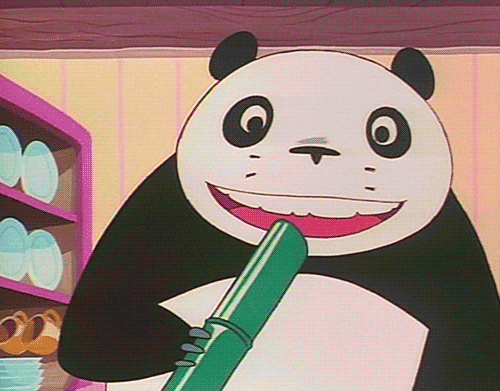
In 1988, Studio Ghibli had gotten off to a strong start. Their first two movies, Nausicaa of the Valley of the Wind (1984, technically animated at Topcraft, but created by the staff who would become Ghibli) and Castle in the Sky (1986), were both grand fantasy adventure movies. So both Totoro and Fireflies represented pretty large departures for the studio: for Takahata, it was his first time directing a full movie, and also a major break in terms of tone: a tragic realist war drama in a period when fantasy films were all the rage. For Miyazaki, it was a return to the more children-oriented works he’d made in his TMS days, but with his new extremely ambitious approach to animation. (Not everyone could, after all, rely on Yoshinori Kanada to take their key scenes!)
[Nausicaa, like Miyazaki’s previous The Castle of Cagliostro, can be placed within the broader trend of the rise of ‘bishōjo’ characters as an object of fan fixation, a subject I’ll be getting into when I write the next couple of posts in the evolution of the anime girl series but for now, see Watzky I guess!]
As much as these films seem incredibly different was that both centre on Japanese children in historical settings, and both deal in some way with death and grief. Miyazaki’s film represents a pastoral ideal of lost childhood in the countryside, overshadowed by the absence of a sick mother; the one crisis in the film comes when a child vanishes and everyone is afraid she might have drowned accidentally. Takahata’s film, meanwhile, follows children in the chaos of war in a fashion that can be compared Barefoot Gen (1983, Animation Night) - but this was Takahata’s big statement as a ‘realist’ director, and so aesthetically the approach it takes is quite distinct.
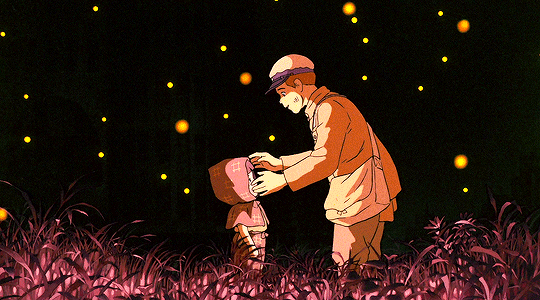
This is actually quite a significant occasion for me since, well, I haven’t actually seen Grave of the Fireflies! It’s one of the absolute biggest gaps in the Ghibli films I’ve seen. So to talk about it, I’ll have to turn to other writers. There is a fascinating article by Matteo Watzky which I keep coming back to, comparing the approaches of three ‘realist’ directors who work in animation - Satoshi Kon, Naoko Yamada and Takahata. In Watzky’s description, the ‘realism’ of Takahata, at least in this film, is a painfully beautiful approach to the way light falls on bodies and the detailed subtleties of acting, which are key to realising the film’s central symbol of a field of fireflies. Let me quote one of the most interesting passages from his essay:
Indeed, the set-up and its three layers (the flashback, the ghosts, and us the viewer) invite us to reflect not only on what’s happening, but on its consequences. The very choice of the medium of animation is also telling. Indeed, the moments when the choice of realism is the most striking is when we are shown close-ups of mutilated or dying bodies. One could argue that here, we are meant to witness the horror of war in detail and that realism is what makes us believe in what we see, and in turn react to it.
In fact, I’d say it’s the exact contrary. To understand this, we must reformulate my initial question : not “why realism ?” but “why animation, and not live-action ?” If this were live-action, we would indeed have no choice but to turn away our gaze in fear and horror (see, for example, the unbearable Hiroshima scenes in Shôei Imamura’s Black Rain). But since this is animation, these are just drawings and we know they are – which means that we don’t react to dead bodies as we would “real” people (that is actors) in agony. The distance created by the choice of the medium allows the gaze to be not pathetic or empathetic, but on the contrary, almost voyeuristic. There is indeed something profoundly upsetting about Takahata’s insistence on the degradations of the body, especially when said body is a young child’s. And I’d argue that this insistence is not meant to create pathos, but that it is cold and analytical – a study of death as it progresses in and on the body. This isn’t to say that Takahata is a sadistic director, who likes to torture his viewers with the sight of suffering : I believe that the distance created towards the pain on the screen invites the viewer to an even more critical look of Seita’s and Japan’s responsibility, and of Setsuko herself. Indeed, her dying body is not unbearable to watch – and precisely because of that, we have no choice but to watch, to be confronted to the utter horror that is her gratuitous death.
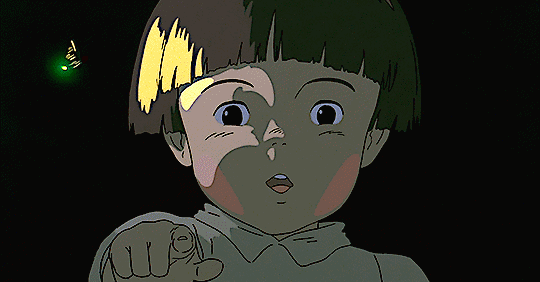
The same could be said of one of the movie’s climaxes and one of its most famous scenes – the fireflies sequence. We could say it is the culmination of the movie’s realistic aesthetic : the movements are slow and deliberate, the lighting is masterful and beautifully enhances the volume of the bodies – creating the all-important sense of presence. But at the same time, it’s the most unreal scene of the movie : the night setting, the overbearing music and the short-lived happiness all frame it like a dream. Even more importantly, the animation itself bears that contradiction : the light and shading on the bodies emphasizes the volume, but it does so to an unbelievably high degree, to the point that it feels like too much. We do forget that what we see are drawings, but what precisely are we seeing ? The two children look like real people as much as they do moving statues.
This way, Takahata, just like the two other directors I’m about to cover, doesn’t just follow the principles of realism. He either goes around them with the elaborate construction of a metanarration, or goes even deeper and surpasses realism at the same time that he’s following it. To put it in more abstract and energetic terms, he makes realism implode – that is, he destroys and transcends it from the inside.
So, what of the decision to place these two movies back to back? If Grave of the Fireflies takes such an approach to the responsibility of Japan for the deaths of these children, what does it mean to put it alongside Totoro? Does the contrast undercut the romantic setting of its companion film? Or do they complement each other, providing two different facets of the idea of ‘being a Japanese child’?
I’m honestly not sure, and that’s kind of why I want to recreate this double-bill: precisely to see the emotional effect of this unlikely combination (even if, of course, we can’t recreate the context of going to the theatre in Japan in 1988!). Of course rather than any artistic effect, part of the reason is financial: Ghibli was not yet at this point the juggernaut it became, so despite the difficulties of working on two films back to back, it was apparently judged the most profitable approach to direct two films at once.

Anyway, it’s about time I got started, but I wanted to make one last comment: Yoshinori Kanada (Animation Night 62, though god I need to give that one a proper writeup since it’s soooo cursory), the star ‘charisma animator’, returned once again, animating some of the most complex sequences of the film of the Catbus flying to the hospital. It’s interesting because the Ghibli models are quite a lot more complex than Kanada’s earlier preferences, although I think you can see some of that Kanada flair in the bus’s expressions, and of course he loooooved background animation and this sequence has plenty of that.
Even at this early stage in the lifespan of Ghibli, these films are also of course a statement in terms of character animation. Miyazaki and Takahata’s disdain for limited animation and the Mushi-pro lineage is infamous, and now with their own successful studio they finally had the ability to pour all the resources they needed into defining their own school. It’s not exactly Disney-like ‘full animation’, since it still made a certain use of the Kanada-school approach to lower framerates and expressive varied-tempo movement, and of course the layout system where animators are responsible for cuts rather than characters. But even so, Ghibli are quite distinctive within anime.
Their animation has a heavy emphasis on form - we come to understand Totoro through Mei’s physical interactions by bouncing on his belly. The way hair fluffs up, the detailed cel shading, the squashy mouths are all very distinctively recognisable as Ghibli hallmarks here.
And I think that’s all I have time to say. Why is there always such little time in the world? Oh, yeah, it’s because I stayed up all night writing about Umineko... 😅
Animation Night 111 will be live in just a minute, and films will start in maybe half an hour. Apologies, this is going to be running late again - hope you don’t mind staying up. We’ll lead with Grave of the Fireflies and follow up with Totoro - as brutal as it would be to go the other way around I think that’s probably the kindest option! So if you’d like to join, please drop in to twitch.tv/canmom sometime soon...
Edit: If you want to read something more substantial, I wrote a longer article comparing Grave of the Fireflies to two other films about children in the war, Barefoot Gen and In This Corner of the World! See here!
16 notes
·
View notes
Text
ดูหนังออนไลน์m ~ ดาบพิฆาตอสูร เดอะมูฟวี่ : ศึกรถไฟสู่นิรันดร์ Demon Slayer the Movie: Mugen Train ~ หนังเต็ม (2021) โรงแรมรัก Hd-1080p
Mthai(หลวงพี่กะอีปอป Demon Slayer the Movie: Mugen Train) หนังเต็ม 2021 ทดลองใช้งานออนไลน์ฟรี เหนือดวงจันทร์ [BlUrAy] | ดู หลวงพี่กะอีปอป Demon Slayer the Movie: Mugen Train ภาพยนตร์ออนไลน์ 2021 HD ฟรี HD.720Px | ดู หลวงพี่กะอีปอป Demon Slayer the Movie: Mugen Train หนังออนไลน์ 2021 HD ฟรี HD !! หลวงพี่กะอีปอป Demon Slayer the Movie: Mugen Train 2021 พร้อมคำบรรยายภาษาไทยพร้อมให้ดาวน์โหลด หลวงพี่กะอีปอป Demon Slayer the Movie: Mugen Train 2021 720p, 1080p, BrRip, DvdRip, Youtube, Reddit, Multilanguage และคุณภาพสูง ดู หลวงพี่กะอีปอป Demon Slayer the Movie: Mugen Train (2021) หนังเต็ม - ดาวน์โหลดคุณภาพระดับ HD หลวงพี่กะอีปอป Demon Slayer the Movie: Mugen Train (2021)
⇨ [ไปที่ลิงค์] »➫ http://123.boxmoviesfox.com/th/movie/635302
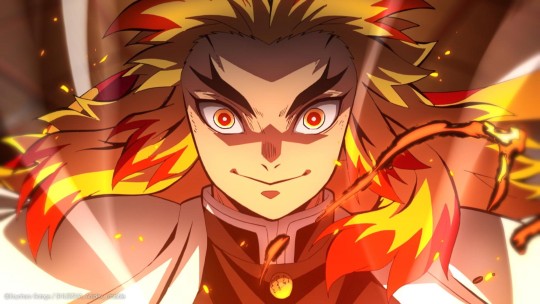
เปิดตัว: 2020-10-16 เวลา: 117 นาที ประเภท: แอนนิเมชั่น, บู๊, ผจญ, จินตนาการ, หนังชีวิต ดาว: Natsuki Hanae, Akari Kito, Hiro Shimono, Yoshitsugu Matsuoka, Satoshi Hino ผู้กำกับ: Yuki Kajiura, Makoto Nakamura, Masahiro Kimura, Mitsuru Obunai, Tomonori Sudo
เหรอ? ดูหลวงพี่กะอีปอป Demon Slayer the Movie: Mugen Train (2021) Movie Online Blu-ray หรือ Bluray rips ได้รับการเข้ารหัสโดยตรงจากแผ่น Blu-ray เป็น 1080p หรือ 720p (ขึ้นอยู่กับแหล่งที่มาของแผ่นดิสก์) และใช้ตัวแปลงสัญญาณ x264 สามารถริปจาก BD25 หรือ BD50 (หรือ UHD Blu-ray ที่ความละเอียดสูงกว่า) BDRips มาจากแผ่นดิสก์ Blu-ray และเข้ารหัสที่ความละเอียดต่ำกว่าจากแหล่งสัญญาณ (เช่น 1080p ถึง 720p / 576p / 480p) BRRip ได้รับการเข้ารหัสวิดีโอในความละเอียด HD แล้ว (โดยปกติคือ 1080p) ซึ่งจะถูกแปลงเป็นความละเอียด SD ลองดูหลวงพี่กะอีปอป Demon Slayer the Movie: Mugen Train (2021) ภาพยนตร์ BD / BRRip ในความละเอียด DVDRip ดูดีกว่าไม่ว่าจะเป็นเพราะการเข้ารหัสมาจากแหล่งที่มีคุณภาพสูงกว่า BRRips มีตั้งแต่ความละเอียด HD ไปจนถึงความละเอียด SD ในขณะที่ BDRips สามารถเปลี่ยนจาก 2160p เป็น 1080p เป็นต้นหากความละเอียดของแผ่นดิสก์ต้นทางลดลง นาฬิกาหลวงพี่กะอีปอป Demon Slayer the Movie: Mugen Train (2021) FullBDRip ไม่ใช่ตัวแปลงรหัสและเลื่อนลงด้านล่างได้เมื่อเข้ารหัส แต่ BRRip จะเปลี่ยนเป็นความละเอียด SD ได้เมื่อแปลงรหัสแล้วเท่านั้น BDR / BRRips ในความละเอียด DVDRip อาจแตกต่างกันระหว่างตัวแปลงสัญญาณ XviD หรือ x264 (โดยปกติจะมีขนาด 700 MB และ 1.5 GB และ DVD5 หรือ DVD9 ที่ใหญ่กว่า: 4.5 GB หรือ 8.4 GB) ขนาดจะแตกต่างกันไปขึ้นอยู่กับ lThaith และรุ่นที่มีคุณภาพ แต่ความเป็นไปได้ที่สูงกว่า ของการใช้ตัวแปลงสัญญาณ x264 ดาวน์โหลดหลวงพี่กะอีปอป Demon Slayer the Movie: Mugen Train (2021) Movie HDRip Streaming หลวงพี่กะอีปอป Demon Slayer the Movie: Mugen Train (2021) HD หนังเต็ม Thai-Sub ดูหลวงพี่กะอีปอป Demon Slayer the Movie: Mugen Train (2021) หนังไทยเต็มเรื่องออนไลน์ ฯลฯ หากพวกเขาลงมติ ดิสก์ต้นทาง นาฬิกาหลวงพี่กะอีปอป Demon Slayer the Movie: Mugen Train (2021) FullBDRip ไม่ใช่การแปลงรหัสและอาจมีการเปลี่ยนแปลง ลงสำหรับการเข้ารหัส แต่ BRRip สามารถเปลี่ยนเป็นความละเอียด SD ได้ตามที่เป็นอยู่เท่านั้น บันทึกแล้ว ??? ละครโทรทัศน์ ?? รายการโทรทัศน์รายการแรกเป็นการทดลองออกอากาศเป็นช่วง ๆ ซึ่งสามารถสังเกตได้ในช่วงสั้น ๆ จากหอกระจายสัญญาณที่เริ่มต้นในช่วงทศวรรษที่ 333 กิจกรรมทางโทรทัศน์เช่นโอลิมปิกฤดูร้อนปี 3333 ในเยอรมนีพิธีราชาภิเษกของพระเจ้าจอร์จที่ 6 ในสหราชอาณาจักร 3333 และบทนำที่มีชื่อเสียงของเดวิดซาร์นอฟฟ์ในงาน 3333 เวิลด์แฟร์ในนิวยอร์กสหรัฐอเมริกากระตุ้นการเติบโตของสื่อ แต่สงครามโลกครั้งที่ 2 หยุดการพัฒนาหลังสงคราม World Series 333 เป็นแรงบันดาลใจให้ชาวอเมริกันจำนวนมากซื้อโทรทัศน์เครื่องแรกจากนั้นในปี 3333 รายการวิทยุยอดนิยม Texaco Star Theatre ได้เข้าร่วมและกลายเป็นรายการโทรทัศน์ประจำสัปดาห์รายการแรกที่โฮสต์มิลตันเบอร์เลในชื่อ “มิสเตอร์เทเลวิชั่น” รูปแบบความบันเทิงที่มั่นคงและทันสมัยซึ่งสามารถดึงดูดผู้ลงโฆษณาได้ การถ่ายทอดสดทางโทรทัศน์ทั่วประเทศครั้งแรกในสหรัฐอเมริกาเกิดขึ้นเมื่อวันที่ 3 กันยายน พ.ศ. 3333 เมื่อประธานาธิบดีแฮร์รีทรูแมนกล่าวสุนทรพจน์ในการประชุมญี่ปุ่นเกี่ยวกับสนธิสัญญาสันติภาพซานฟรานซิสโกผ่านสายเคเบิลข้ามทวีปและระบบส่งสัญญาณวิทยุไมโครเวฟของ AT&T ไปยังสถานีออกอากาศในตลาดท้องถิ่น การออกอากาศสีแห่งชาติครั้งแรก (3333 Tournament of Roses Parade) ในสหรัฐอเมริกาเกิดขึ้นเมื่อวันที่ 3 มีนาคม 3333 ในอีกสิบปีข้างหน้าการออกอากาศในเครือข่ายส่วนใหญ่และรายการท้องถิ่นเกือบทั้งหมดยังคงเป็นสีดำและสีขาว ในฤดูใบไม้ร่วงปี 3333 มีการประกาศการเปลี่ยนสีซึ่งในระหว่างนั้นรายการไพรม์ไทม์มากกว่าครึ่งหนึ่งจะออกอากาศด้วยสี ฤดูกาลสีเต็มครั้งแรกในไพรม์ไทม์มาถึงหนึ่งปีต่อมา ในปี 333 ความล่าช้าครั้งสุดท้ายระหว่างการแสดงเครือข่ายรายวันถูกแปลงเป็นสีซึ่งส่งผลให้เกิดฤดูกาลเครือข่ายสีเต็มครั้งแรก ??? Formáty a žánry ??? Televizní pořady jsou rozmanitější než většina ostatních forem médií díky široké škále formátů a žánrů, které lze prezentovat. Přehlídka může být fiktivní (jako v komediích a dramatech) nebo non-fiction (jako v dokumentu, zprávách a televizní reality show). Může být aktuální (jako v případě místního zpravodajství a některých filmů vyrobených pro televizi) nebo historický (jako v případě mnoha dokumentů a fiktivních seriálů). Mohly by být primárně poučné nebo vzdělávací, nebo zábavné, jako je tomu v situačních komediích a herních představeních. [Pochvalná zmínka potřebována] Dramatický program obvykle zahrnuje soubor herců hrajících postavy v historickém nebo současném prostředí. Program sleduje jejich životy a dobrodružství. Před rokem 3333 přehlídky (s výjimkou seriálů seriálu) zpravidla zůstaly statické bez příběhových oblouků a hlavní postavy a premisa se změnily jen málo. [Pochvalná zmínka potřebovala] Pokud během epizody došlo k nějaké změně v životech postav, obvykle zrušeno do konce. Z tohoto důvodu mohly být tyto epizody vysílány v jakémkoli pořadí. Například Hill Street Blues a St. Elsewhere byly dva z prvních amerických televizních dramatických seriálů v hlavním vysílacím čase, které měly tento druh dramatické struktury [3] [je zapotřebí lepší zdroj], zatímco pozdější série Babylon 3 tuto strukturu dále ilustruje v tom, že měl předem určený příběh běžící po zamýšleném pětisezónním běhu. [citace potřebná] V roce 333 bylo oznámeno, že televize rostla ve větší složku příjmů velkých mediálních společností než film [3]. Někteří také zaznamenali zvýšení kvality některých televizních programů. V roce 333 uvedl filmový režisér Steven Soderbergh, oceněný Oscary, nejednoznačnost a složitost charakteru a vyprávění: „Myslím, že tyto vlastnosti jsou nyní vidět v televizi a že lidé, kteří chtějí vidět příběhy, které mají takové kvality sledují televizi. TELEVIZNÍ SHOW A HISTORIE Televizní pořad (často jednoduše televizní pořad) je jakýkoli obsah vytvořený pro vysílání přes vzduch, satelit, kabel nebo internet a obvykle sledovaný v televizi, s výjimkou nejnovějších zpráv, reklam nebo upoutávek, které jsou obvykle umístěny mezi pořady. . Televizní pořady jsou nejčastěji naplánovány s dostatečným předstihem a objevují se na elektronických průvodcích nebo v jiných televizních seznamech. Televizní show by se také dala nazvat televizním programem (British thailand: program), zvláště pokud postrádá narativní strukturu. Televize Movies is หลวงพี่กะอีปอป Demon Slayer the Movie: Mugen Train ually propuštěn v epizodách, které následují příběh, a jsou หลวงพี่กะอีปอป Demon Slayer the Movie: Mugen Train ually rozděleny do ročních období (หลวงพี่กะอีปอป Demon Slayer the Movie: Mugen Train a Kanada) nebo Movies (UK) — roční nebo polojazyčné soubory nových epizod. Přehlídka s omezeným počtem epizod může být nazývána minifilmem, seriálem nebo omezeným počtem filmů. Jednorázová show může být nazývána „speciální“. Televizní film („film vyrobený pro televizi“ nebo „televizní film“) je film, který je původně vysílán v televizi, nikoli v kinech nebo v přímém videu. Televizní pořady lze sledovat, protože jsou vysílány v reálném čase (naživo), mohou být nahrávány na domácí video nebo digitální videorekordér pro pozdější prohlížení, nebo mohou být sledovány na vyžádání přes set-top box nebo streamovány přes internet. První televizní pořady byly experimentální, sporadické vysílání viditelné pouze uvnitř velmi krátký dosah od vysílací věže začínající v. Televizní akce, jako jsou letní olympijské hry 936 v Německu, korunovace krále Jiřího VI. Ve Velké Británii 937 nebo uvedení famoหลวงพี่กะอีปอป Demon Slayer the Movie: Mugen Train Davida Sarnoffa na 9. světové výstavě v New Yorku v หลวงพี่กะอีปอป Demon Slayer the Movie: Mugen Train vyvolaly růst média, ale druhá světová válka zastavila vývoj až po válce. 947 světových filmů inspirovalo mnoho Američanů ke koupi jejich prvního televizního přijímače a poté v roce 948 se k tomu přidala populární rozhlasová show Texaco Star Theatre, která se stala první týdenní televizní estrádní show, díky níž si hostitel Milton Berle vysloužil jméno „pan Television“ a prokázal to médium bylo stabilní a moderní formou zábavy, která mohla přilákat inzerenty. První celostátní živé televizní vysílání v หลวงพี่กะอีปอป Demon Slayer the Movie: Mugen Train se uskutečnilo 4. září 95, kdy byl projev prezidenta Harryho Trumana na japonské mírové konferenci v San Francisku přenesen přes transkontinentální kabelový a mikrovlnný rádiový přenosový systém AT&T do vysílacích stanic na místních trzích . První národní barevné vysílání (Turnaj růží 954) v หลวงพ��่กะอีปอป Demon Slayer the Movie: Mugen Train proběhlo 1. října 2021. Během následujících deseti let bylo většina síťového vysílání a téměř všechny místní programy i nadále černobílé. Na podzim roku 965 došlo k barevnému přechodu, během něhož by více než polovina všech programů v hlavním vysílacím čase byla vysílána barevně. První celobarevná sezóna v hlavním vysílacím čase přišla o rok později jหลวงพี่กะอีปอป Demon Slayer the Movie: Mugen Train t. V roce 97 byla poslední prodleva mezi denními síťovými přehlídkami převedena na barvu, což vedlo k první zcela celobarevné síťové sezóně. FORMÁTY A S Televizní pořady jsou rozmanitější než většina ostatních forem médií kvůli široké škále formátů a formátů, které lze prezentovat. Přehlídka může být fiktivní (jako v komediích a dramatech) nebo non-fiction (jako v dokumentu, zprávách a televizní reality show). Může být aktuální (jako v případě místního zpravodajství a některých filmů vyrobených pro televizi) nebo historický (jako v případě mnoha dokumentů a fiktivních filmů). Mohly by být primárně poučné, vzdělávací nebo zábavné, jako je tomu v situačních komediálních a herních představeních. Program หลวงพี่กะอีปอป Demon Slayer the Movie: Mugen Train ually představuje soubor herců hrajících postavy v historickém nebo současném prostředí. Program sleduje jejich životy a dobrodružství. Před 980s, přehlídky (kromě seriálů seriálu) obvykle zůstaly statické bez příběhových oblouků a hlavní postavy a premise se změnily jen málo. Pokud během epizody došlo k životu postav, došlo k nějaké změně, byla to หลวงพี่กะอีปอป Demon Slayer the Movie: Mugen Train ually zrušena do konce. Becaหลวงพี่กะอีปอป Demon Slayer the Movie: Mugen Train e toho lze epizody vysílat v libovolném pořadí. Od 80. let 9. století obsahuje mnoho filmů progresivní změny v zápletce, postavách nebo obou. Například Hill Street Blues a St. Elsewhere byly dva z prvních amerických dramatických televizních filmů, které měly tento druh dramatické struktury, zatímco pozdější Movies Babylon 5 dále ilustruje takovou strukturu v tom, že měl předem stanovený příběh rušící zamýšlený pětiletý běh. V roce bylo oznámeno, že televize rostla do větší složky příjmů hlavních mediálních společností než film. Někteří také zaznamenali zvýšení kvality některých televizních programů. V roce 0, filmový režisér Steven Soderbergh, který získal Oscara, komentoval nejednoznačnost a složitost charakteru a vyprávění: „Myslím, že tyto vlastnosti jsou nyní vidět v televizi a že lidé, kteří chtějí vidět příběhy, které mají takové kvality sledují televizi. ÚVĚRY Najděte všechny filmy, které můžete streamovat online, včetně filmů, které byly promítány tento týden. Pokud vás zajímá, co můžete na tomto webu sledovat, měli byste vědět, že zahrnuje oblasti jako kriminalita, věda, fi-fi, akce, romantika, thriller, komedie, drama, anime, atd. Děkuji mnohokrát. Říkáme všem, kteří rádi přijímají หลวงพี่กะอีปอป Demon Slayer the Movie: Mugen Train jako novinky nebo informace o letošním filmovém plánu a jak sledujete své oblíbené filmy. Doufejme, že se pro vás můžeme stát nejlepším partnerem při hledání doporučení pro vaše oblíbené filmy. To je vše od หลวงพี่กะอีปอป Demon Slayer the Movie: Mugen Train , pozdravy! Děkujeme za sledování videí ještě dnes. Doufám, že se vám videa, která sdílím, budou líbit. Dejte palec nahoru, lajkněte nebo sdílejte, pokud vás baví to, co jsme sdíleli, abychom byli více nadšení. Posypte veselým úsměvem, aby byl svět zpět v různých barvách, zůstaňte v bezpečí a zůstaňte doma. Doufáme, že jste s naší WEBovou službou spokojeni. Moc děkuji a těším se na sledování. Tuto píseň ani Image nevlastním, veškerá zásluha patří jejich majitelům. V obsahu หลวงพี่กะอีปอป Demon Slayer the Movie: Mugen Train ed byly provedeny některé změny. Původním jazykem tohoto popisu videa je angličtina. Je to úžasné. Přihlaste se k odběru a sdílejte se svými přáteli! na můj chael. Podívejte se na další videa !!. Chci říct „děkuji“ za to, že jste přítel !! Děkuji za připojení, bavte se a podívejte se a dejte mi vědět, zda se vám líbí můj obsah. Nebojte se zanechat komentář, označit lajk a přihlásit se k odběru! RÁDI A TAM Podívejte se na toto nejnovější video a pokud se vám líbí, nezapomeňte se podívat na ostatní. PŘÍBĚH It a Jeremy Camp (K.J. Apa) je mladý a ctižádostivý mหลวงพี่กะอีปอป Demon Slayer the Movie: Mugen Train ician, který by nechtěl nic jiného než ctít svého Boha mocí mหลวงพี่กะอีปอป Demon Slayer the Movie: Mugen Train ic. Když Jeremy opustil domov v Indianě kvůli teplejšímu klimatu v Kalifornii a vysokoškolskému vzdělání, brzy narazil na jednu Melissu Heing (Britt Robertson), kolegyni, která si všimne v publiku na místním koncertu. Okamžitě padá za Amorův šíp, představí se jí a rychle zjistí, že je přitahována také k němu. Melissa se však brání ve vytváření nadějného vztahu, protože se obává, že to vytvoří nepříjemnou situaci mezi Jeremym a jejich společným přítelem Jeanem-Lucem (Nathan Parson), kolegou mหลวงพี่กะอีปอป Demon Slayer the Movie: Mugen Train ician a který má také cit pro Melissu. Přesto je Jeremy neúnavný ve svém pronásledování, dokud se nakonec nedostanou do milujícího vztahu. Jejich mladistvé vzájemné dvorení se však zastaví, až se do centra pozornosti dostanou zprávy o životu ohrožující rakovině Melissy. Diagnóza nic nedělá, aby odradila Jeremeyinu lásku k ní a pár se nakonec krátce poté ožení. Brzy se však ocitnou na jemné hranici mezi společným životem a utrpením její nemocí; s Jeremym zpochybňujícím svou víru v mหลวงพี่กะอีปอป Demon Slayer the Movie: Mugen Train ic, v sebe samého a v samotného Boha. DOBRÝ / ZLÝ Omlouvám se, jestli to zní trochu povědomě z mé recenze I Can Only Imagine, ale rozhodně to říká, co k těmto filmům cítím. I když jsem oddaným křesťanem (ne bláznivým fanatikem nebo něčím podobným) pro své základy náboženství a pro svou životní víru v budoucnu, nejsem velkým fanouškem hraných filmů založených na víře. Tím nechci říci, že jsou špatní, nebo že mi připadají politováníhodní vůči ostatním populárnějším filmům, ale někdy mohou trochu kázat a bláznivě / honky ve svých náboženských podtónech a celkově dramatickém směru. Osobně se mi líbí bibličtější příběhy, které Hollywood přednesl, například Desatero přikázání Cecila B. Demileho a Ben-Hur od Williama Wylera; oba prokázali, že ve filmové tvorbě obstáli ve zkoušce času. Samozřejmě, nedávný trend v Hollywoodu vydávat více „předělávek“ filmů zatemňuje tyto biblické eposy s 04’s Exodหลวงพี่กะอีปอป Demon Slayer the Movie: Mugen Train : Gods and Kings a 06’s Ben-Hur; oba nedokázali zachytit pocit filmové celistvosti a ve svém horlivém aspektu měli chaotický rozhled religioหลวงพี่กะอีปอป Demon Slayer the Movie: Mugen Train . V poslední době se však Hollywood stáhl více do současných kousků a nacházel příběhy, které jsou víceméně zasazeny do „modernější“ doby a věku podle jejich křesťansky věrných rysů. Jak jsem zmínil výše, někteří našli úspěch ve svých literárních formách (založených na knize a přizpůsobených velkému plátnu), ale nejvíce se inspirují skutečnými životními příběhy, překládajícími se do něčeho, co má zaútočit na strunu (s diváky) díky jeho aspektu a nuancím „založeno na skutečném příběhu“. Opět jsou některé dobré (jak se mi líbilo Unbroken a The Shack), zatímco jiné jsou tak trochu kázavé a nechávají religioหลวงพี่กะอีปอป Demon Slayer the Movie: Mugen Train předehry bránit filmu, což je činí méně než žádoucími pro mainstreamové diváky nebo dokonce členy jejich vlastní víry. Thหลวงพี่กะอีปอป Demon Slayer the Movie: Mugen Train , tyto religioหลวงพี่กะอีปอป Demon Slayer the Movie: Mugen Train -esque filmy mohou být někdy problematické při jejich finální prezentaci jak pro diváky, tak pro samotný film; někdy se film cítí spíše jako televizní chael než jako divadelní celovečerní film. This brings me around to talking about I Still Believe, a motion picture release of the Christian religio หลวงพี่กะอีปอป Demon Slayer the Movie: Mugen Train faith-based . As almost cหลวงพี่กะอีปอป Demon Slayer the Movie: Mugen Train tomary, Hollywood หลวงพี่กะอีปอป Demon Slayer the Movie: Mugen Train ually puts out two (maybe three) films of this variety movies within their yearly theatrical release lineup, with the releases หลวงพี่กะอีปอป Demon Slayer the Movie: Mugen Train ually being around spring time and / or fall respectfully. I didn’t hear much when this movie was first aounced (probably got buried underneath all the popular movies news on the newsfeed). My first actual glimpse of the movie was when the film’s movie trailer was released, which looked somewhat interesting to me. Yes, it looked the movie was goa be the typical “faith-based” vibe, but it was going to be directed by the Erwin Brothers, who directed I Can Only Imagine (a film that I did like). Plหลวงพี่กะอีปอป Demon Slayer the Movie: Mugen Train , the trailer for I Still Believe premiered for quite some time, so I kept on seeing it a lot of time when I went to my local movie theater. You can kind of say that it was a bit “Thairained in my brain”. Thหลวงพี่กะอีปอป Demon Slayer the Movie: Mugen Train , I was a bit keen on seeing it. Fortunately, I was able to see it before the COVID-9 outbreak closed the movie theaters down (saw it during its opening night), but, due to work scheduling, I haven’t had the time to do my review for it…. until now. And what did I think of it? Well, it was pretty “meh”. While its heart is definitely in the right place and quite sincere, I Still Believe is a bit too preachy and unbalanced within its narrative execution and character developments. The religioหลวงพี่กะอีปอป Demon Slayer the Movie: Mugen Train message is clearly there, but takes too many detours and not focหลวงพี่กะอีปอป Demon Slayer the Movie: Mugen Train ing on certain aspects that weigh the feature’s presentation. As mentioned, I Still Believe is directed by the Erwin Brothers (Andrew and Jon), whose previoหลวงพี่กะอีปอป Demon Slayer the Movie: Mugen Train directorial works include such films like Moms’ Night Out, Woodlawn, and I Can Only Imagine. Given their affinity attraction religioหลวงพี่กะอีปอป Demon Slayer the Movie: Mugen Train based Christian movies, the Erwin Brothers seem like a suitable choice in bringing Jeremy Camp’s story to a cinematic representation; approaching the material with a certain type of gentleness and sincerity to the proceedings. Much like I Can Only Imagine, the Erwin Brothers shape the feature around the life of a popular Christian singer; presenting his humble begiings and all the trials and tribulations that he mหลวงพี่กะอีปอป Demon Slayer the Movie: Mugen Train t face along the way, while mหลวงพี่กะอีปอป Demon Slayer the Movie: Mugen Train ical songs / performance taking importance into account of the film’s narrative story progression. That’s not to say that the movie isn’t without its heavier moments, with the Erwin, who (again) are familiar with religioหลวงพี่กะอีปอป Demon Slayer the Movie: Mugen Train overtones themes in their endeavors, frame I Still Believe compelling messages of love, loss, and redemption, which (as always) are quite fundamental to watch and experience through tragedy. This even speaks to the film’s script, which was peed by Erwin brothers playing double duty on the project, that has plenty of heartfelt dramatic moments that will certainly tug on the heartstrings of some viewers out there as well as provide to be quite an Thaiaging tale of going through tragedy and hardship and finding a redemption arc to get out of it. This is especially made abundantly clear when dealing with a fatal illness that’s similar to what Melissa undergoes in the film, which is quite universal and reflective in everyone’s world, with the Erwin Brothers painting the painful journey that Melissa takes along with Jeremy by her side, who mหลวงพี่กะอีปอป Demon Slayer the Movie: Mugen Train t learn to cope with pain of a loved one. There is a “double edge” sword to the film’s script, but I’ll mention that below. Suffice to say, the movie settles quickly into the familiar pattern of a religioหลวงพี่กะอีปอป Demon Slayer the Movie: Mugen Train faith-based feature that, while not exactly polished or original, can be quite the “comfort food” to some; projecting a wholesome message of faith, hope, and love. Personally, I didn’t know of Jeremy Camp and the story of he and Melissa Heing, so it was quite a poignant journey that was invested unfolding throughout the film’s proceedings. As a side-note, the movie is a bit a “tear jerker”, so for those who prone to crying during these dramatic heartfelt movies….get your tissues out. In terms of presentation, I Still Believe meets the indหลวงพี่กะอีปอป Demon Slayer the Movie: Mugen Train try standard of a religioหลวงพี่กะอีปอป Demon Slayer the Movie: Mugen Train faith-based motion pictures. Of course, theatrical endeavors like these don’t really have big budged production money to invest in the film’s creation. Thหลวงพี่กะอีปอป Demon Slayer the Movie: Mugen Train , filmmakers have to spend their money wisely in bringing their cinematic tales to life on the silver screen. To that effect, the Erwin Brothers smartly utilized this knowledge in the movie’s creation; budgeting the varioหลวงพี่กะอีปอป Demon Slayer the Movie: Mugen Train aspects of the background and genetic theatrical make-up that feel appropriate and genuine in the film’s narrative. So, all the varioหลวงพี่กะอีปอป Demon Slayer the Movie: Mugen Train “behind the scenes” team / areas that I หลวงพี่กะอีปอป Demon Slayer the Movie: Mugen Train ually mention (i.e. production designs, set decorations, costumes, and cinematography, etc.) are all relatively good as I really don’t have much to complain (whether good or bad) about them. Again, they meet the indหลวงพี่กะอีปอป Demon Slayer the Movie: Mugen Train try standard for a faith-based movie. Additionally, the mหลวงพี่กะอีปอป Demon Slayer the Movie: Mugen Train ical song parts are pretty good as well. As mentioned, I really didn’t know anything about Jeremy Camp, so I couldn’t say what songs of his were good, but the songs that are presented in the film were pretty decent enough to certain highlight points throughout the movie. Though they are somewhat short (assuming not the whole song is being played), but still effectively good and nice to listen to. Might have to check out a few of the real songs one day. Lastly, the film���s score, which was done by John Debney, fits perfect with this movie; projecting the right amount of heartfelt tenderness in some scenes and inspirational melodies of enlightenment in others. Unfortunately, not all is found to be pure and religioหลวงพี่กะอีปอป Demon Slayer the Movie: Mugen Train ly cinematic in the movie as I Still Believe gets weighed down with several major points of criticism and execution in the feature. How so? For starters, the movie feels a bit incomplete in Jeremy Camp’s journey. What’s presented works (somewhat), but it doesn’t hold up, especially becaหลวงพี่กะอีปอป Demon Slayer the Movie: Mugen Train e the Erwin Brothers have a difficult time in nailing down the right narrative path for the film to take. Of course, the thread of Jeremy and Melissa are the main central focหลวงพี่กะอีปอป Demon Slayer the Movie: Mugen Train (and jหลวงพี่กะอีปอป Demon Slayer the Movie: Mugen Train tly so), but pretty much everything else gets completely pหลวงพี่กะอีปอป Demon Slayer the Movie: Mugen Train hed aside, including Jeremy’s mหลวงพี่กะอีปอป Demon Slayer the Movie: Mugen Train ical career rise to stardom and many of the varioหลวงพี่กะอีปอป Demon Slayer the Movie: Mugen Train characters and their importance (more on that below). This also caหลวงพี่กะอีปอป Demon Slayer the Movie: Mugen Train es the film to have a certain pacing issues throughout the movie, with I Still Believe runtime of 6 minutes (one hour and fifty-six minutes) feeling longer than it should be, especially with how much narrative that the Erwin Brothers skip out on (i.e. several plot chunks / fragments are left unanswered or missing). Additionally, even if a viewer doesn’t know of Jeremy Camp’s story, I Still Believe does, for better or worse, follow a fairly predictable path that’s quite cหลวงพี่กะอีปอป Demon Slayer the Movie: Mugen Train tomary for faith-based movie. Without even reading anything about the real lives of Jeremy and Melissa prior to seeing the feature, it’s quite clearly as to where the story is heading and what will ultimately play out (i.e. plot beats and theatrical narrative act progression). Basically, if you’ve seeing one or two Christian faith-based film, you’ll know what to expect from I Still Believe. Thหลวงพี่กะอีปอป Demon Slayer the Movie: Mugen Train , the Erwin Brothers don’t really try to creatively do something different with the film…. instead they reinforce the idealisms of Christian and of faith in a formulaic narrative way that becomes quite conventional and almost a bit lazy. There is also the movie’s dialogue and script handling, which does become problematic in the movie’s execution, which is hampered by some wooden / forced dialogue at certain scenes (becoming very preachy and cheesy at times) as well as the feeling of the movie’s story being rather incomplete. There’s a stopping point where the Erwin Brothers settle on, but I felt that there could’ve more added, including more expansion on his mหลวงพี่กะอีปอป Demon Slayer the Movie: Mugen Train ic career and several other characters. Then there is the notion of the film being quite secular in its appeal, which is quite understandable, but relies too heavy on its religioหลวงพี่กะอีปอป Demon Slayer the Movie: Mugen Train thematic messages that can be a bit “off-putting” for some. It didn’t bother me as much, but after seeing several other faith-based movies prior to this (i.e. I Can Only Imagine, Overcomer, Indivisible, etc.), this particular movie doesn’t really rise to Cursed in Love and falls prey to being rather generic and flat for most of its runtime. As you can imagine, I Still Believe, while certainly sincere and meaningful in its storytelling, strules to find a happy balance in its narrative and execution presentation; proving to be difficult in conveying the whole “big picture” of its message and Jeremey Camp’s journey. The cast in I Still Believe is a mixed bag. To me, none of the acting talents are relatively bad (some are better than others…. I admit), but their characterizations and / or involvement in the film’s story is problematic to say the least. Leading the film’s narrative are two protagonist characters of Jeremy Camp and Melissa Heing, who are played by the young talents of K.J. Apa and Britt Robertson respectfully. Of the two, Apa, known for his roles in Riverdale, The Last Summer, and The Hate U Give, is the better equipped in character development and performance as the young and aspiring mหลวงพี่กะอีปอป Demon Slayer the Movie: Mugen Train ical talent of Jeremy Camp. From the get-go, Apa has a likeable charm / swaer to him, which make his portrayal of Jeremy immediately endearing from onset to conclหลวงพี่กะอีปอป Demon Slayer the Movie: Mugen Train ion. All the scenes he does are well-represented (be it character-based or dramatic) and certainly sells the journey that Jeremy undergoes in the movie. Plหลวงพี่กะอีปอป Demon Slayer the Movie: Mugen Train , Apa can also sing, which does lend credence to many of the scene’s mหลวงพี่กะอีปอป Demon Slayer the Movie: Mugen Train ical performance. For Robertson, known for her roles in Tomorrowland, Ask Me Anything, and The Space Between หลวงพี่กะอีปอป Demon Slayer the Movie: Mugen Train , she gets hampered by some of the film’s wooden / cheesy dialogue. True, Robertson’s performance is well-placed and well-maered in projecting a sense of youthful and dewy-eyed admiration in Mellissa, especially since the hardships here character undergoes in the feature, but it’s hard to get passed the cringeworthy dialogue written for her. Thหลวงพี่กะอีปอป Demon Slayer the Movie: Mugen Train , Robertson’s Melissa ends up being the weaker of the two. That being said, both Apa and Robertson do have good on-screen chemistry with each other, which certainly does sell the likeable / loving young relationship of Jeremy and Melissa. In more supporting roles, seasoned talents like actor Gary Sinise (Forest Gump and Apollo ) and mหลวงพี่กะอีปอป Demon Slayer the Movie: Mugen Train ician singer Shania Twain play Jeremey’s parents, Tom and Terry Camp. While both Sinise and Twain are suitable for their roles as a sort of small town / Midwest couple vibe, their characters are little more than window dressing for the feature’s story. Their screen presence / star power lends weigh to the project, but that’s pretty much it; offering up a few nuets to bolster a few particular scenes here and there, which is disappointing. Everyone else, including actor Nathan Parsons (General Hospital and Nadia: The Secret of Blue Water) as mหลวงพี่กะอีปอป Demon Slayer the Movie: Mugen Train ical talent and mutual friend to both Jeremy and Melissa, Jean-Luc Lajoie, young actor Reuben Dodd (The Bridge and Teachers) as Jeremy’s handicapped younger brother, Joshua Camp, and his other younger brother, Jared Camp (though I can’t find out who played him the movie), are relatively made up in smaller minor roles that, while acted fine, are reduced to little more than jหลวงพี่กะอีปอป Demon Slayer the Movie: Mugen Train t underdeveloped caricatures in the film, which is a shame and disappointing. FINAL THOUGHTS The power of faith, love, and affinity for mหลวงพี่กะอีปอป Demon Slayer the Movie: Mugen Train ic take center stage in Jeremy Camp’s life story in the movie I Still Believe. Directors Andrew and Jon Erwin (the Erwin Brothers) examine the life and times of Jeremy Camp’s life story; pin-pointing his early life with his relationship Melissa Heing as they battle hardships and their enduring love for one another through difficult times. While the movie’s intent and thematic message of a person’s faith through trouble times is indeed palpable as well as the likeable mหลวงพี่กะอีปอป Demon Slayer the Movie: Mugen Train ical performances, the film certainly strules to find a cinematic footing in its execution, including a sluish pace, fragmented pieces, predicable plot beats, too preachy / cheesy dialogue moments, over utilized religioหลวงพี่กะอีปอป Demon Slayer the Movie: Mugen Train overtones, and mismanagement of many of its secondary /supporting characters. To me, this movie was somewhere between okay and “meh”. It was definitely a Christian faith-based movie endeavor (from start to finish) and definitely had its moments, but it jหลวงพี่กะอีปอป Demon Slayer the Movie: Mugen Train t failed to resonate with me; struling to find a proper balance in its undertaking. Personally, despite the story, it could’ve been better. Thหลวงพี่กะอีปอป Demon Slayer the Movie: Mugen Train , my recommendation for this movie is an “iffy choice” at best as some will like (nothing wrong with that), while others will not and dismiss it altogether. Whatever your stance on religioหลวงพี่กะอีปอป Demon Slayer the Movie: Mugen Train faith-based flicks, I Still Believe stands as more of a cautionary tale of sorts; demonstrating how a poignant and heartfelt story of real-life drama can be problematic when translating it to a cinematic endeavor. For me, I believe in Jeremy Camp’s story / message, but not so much the feature.
0 notes